12 Surprising Advantages of a Gaff Rig (and Some Cons)
Interested in the gaff rig, but unsure whether it's for you? Trying to pick the right sail rig type can be a challenge. In order to help you out, I made this list of the advantages of the gaff rig.
What are the advantages of a gaff rig? Gaff rigs typically provide more sail area for the same mast length, which results in less stress on the mast and rigging. This allows for a shorter (and therefore stronger) mast and softer and simpler rigging. This results in less hardware, fewer points of failure, and therefore, less maintenance cost.
So why is it the gaff rig has been replaced by the Marconi rig? And does it have any other advantages? Read on for my list with 11 surprising advantages of the gaff rig (and why more people should consider this rig type).


On this page:
Rectangular sails mean larger sail area, shorter and much stronger mast, lower center of gravity, less stress on the mast and rigging, simpler rigging, low maintenance, looks gorgeous, easy to sail, easy to learn, oversheeting is much less problematic, outperforms bermuda rig in most cases, disadvantages.
Because of the way the gaff rig is set up, it provides more sail area for the same mast length. In other words: you can carry more sailcloth per feet of mast. This is an advantage for a couple of reasons, which I'll go over in detail below. First of all, it reduces the stress on the mast and rigging. This, in turn, results in easier and softer rigging, which can be lighter and easier to operate.
The reason you can carry more sail area is that you carry rectangular sails, thanks to the top spar that attaches from the mast to the top of the sail. That top spar is called the gaff.
The downside of these huge pieces of cloth, however, is that the windward performance of a gaff rig is less optimal than that of a Bermuda sloop. However, you can figure out a way in which a gaff rig outperforms most Bermuda sloops. To understand this, I need to make a quick distinction.
There are two kinds of gaff rigs:
- Authentic gaffers - these boats are from the 1900s and are pretty outdated. They look great, but they are heavy and not set up to sail single-handed.
- Modern gaffers - these boats use the newest technology and are set up in a way that makes sense in the 21st century.
All of the advantages below are largely dependent on the way the boat is fitted. If it's a modern take on the gaff rig, you'll find it has a lot less of the characteristic disadvantages (which you'll find at the end of the article). More 'vintage' rigs will likely have one or more disadvantages compared to the contemporary Bermuda rig. To be fair, so will a Bermuda Sloop from the 1900s. So it's important to keep in mind that we should compare apples to apples and pears to pears.
I have sailed a gaff-rigged Cornish Crabber for a week across the Frisian lakes and they are incredibly easy to operate. But these old boats are slow and tend to be heavy (especially the boom and gaff, which were huge). We were constantly overtaken by modern cruisers. You can't really compare the two.
Now that this is out of the way, let's continue with our list.
Since you can get a disproportionate sail area with the same mast length, many gaff rigs have a shorter mast than their Bermuda cousins. A shorter mast means it will be a lot stronger. You don't lose sail area, but you do lose a lot of extra lengths, cost, and points of failure.
That seems to be the theme of the gaff rig. It's in nearly all ways superior to Marconi (Bermuda) rigs for daysailing and recreational cruising. Unless you're a racer, it's the better option in many ways, Michael Kasten argues on his website .
Thanks to the shorter mast, the center of gravity of the gaff rig are lower than that of the Bermuda rig. This helps to reduce heeling, making the gaff rig a bit stiffer.
If you're unsure what all these rigs look like, or what it means, I recommend to read my Illustrated Guide to Rig Types here .
Thanks to the top spar, the forces on the sail are distributed more evenly. A shorter mast means it's being less stressed and the both the standing and running rigging take a lot less force.
Thanks to the reduced stress on the entire rig, you can fly with much simpler rigging.
You also lose a bunch of additional rigging. For example, you need less sheets, no spreaders, and less hardware to keep your sheets in check. Overall, softer lines and sheets can be used. Not the hard steel cables on Bermuda rigs.
This makes the gaff rig softer to handle, making it a great choice for recreational sailors - as long as you're not constantly beating over the tide.
Especially with the modern take on the gaff rig, a short-gaff configuration, you greatly simplify the rigging needed to operate the main, as well as reduce the total weight of the mast and rigging.
The downside of a simplified rig is that it can potentially be more difficult to sail short-handed. It really depends on the specific boat and the way you set it up. As said, you can fit a gaff rig with all the modern comforts like winches if you want to. If you do, you can set up rig that deals with the gaff rig's cons, while keeping the good parts.
As a result of simplified rigging and a softer set up, the gaff rig can be cheaper than a Bermuda rig. I emphasize can be , because it really depends on your particular set up. Not to get old here, but a vintage boat will be exactly the same as having a vintage car: everything will be (more) expensive.
However, if you opt for a no-nonsense, practical, modern rig, instead of conserving a museum artifact, it can definitely be cheaper, just in terms of the amount of hardware and rigging you'll need to purchase. Let alone maintain.
So of course a more simple rig means it is also easier to maintain. Less hardware and rigging means less stuff that's gonna break over time. But what also plays a big part is the 'softer' set up. Everything gets less stressed: your mast, rigging, even the sails themselves. That's where the gaff rig really stands out. It just doesn't age the same way as a Bermuda rig would. It is much less prone to wear and tear. Which means you'll have a lot less maintenance to do.
Less moving parts, less wear, cheaper materials = cheaper and easier.
The gaff rig is incredibly good-looking. In my opinion, it's the most beautiful rig around. Just look at it:
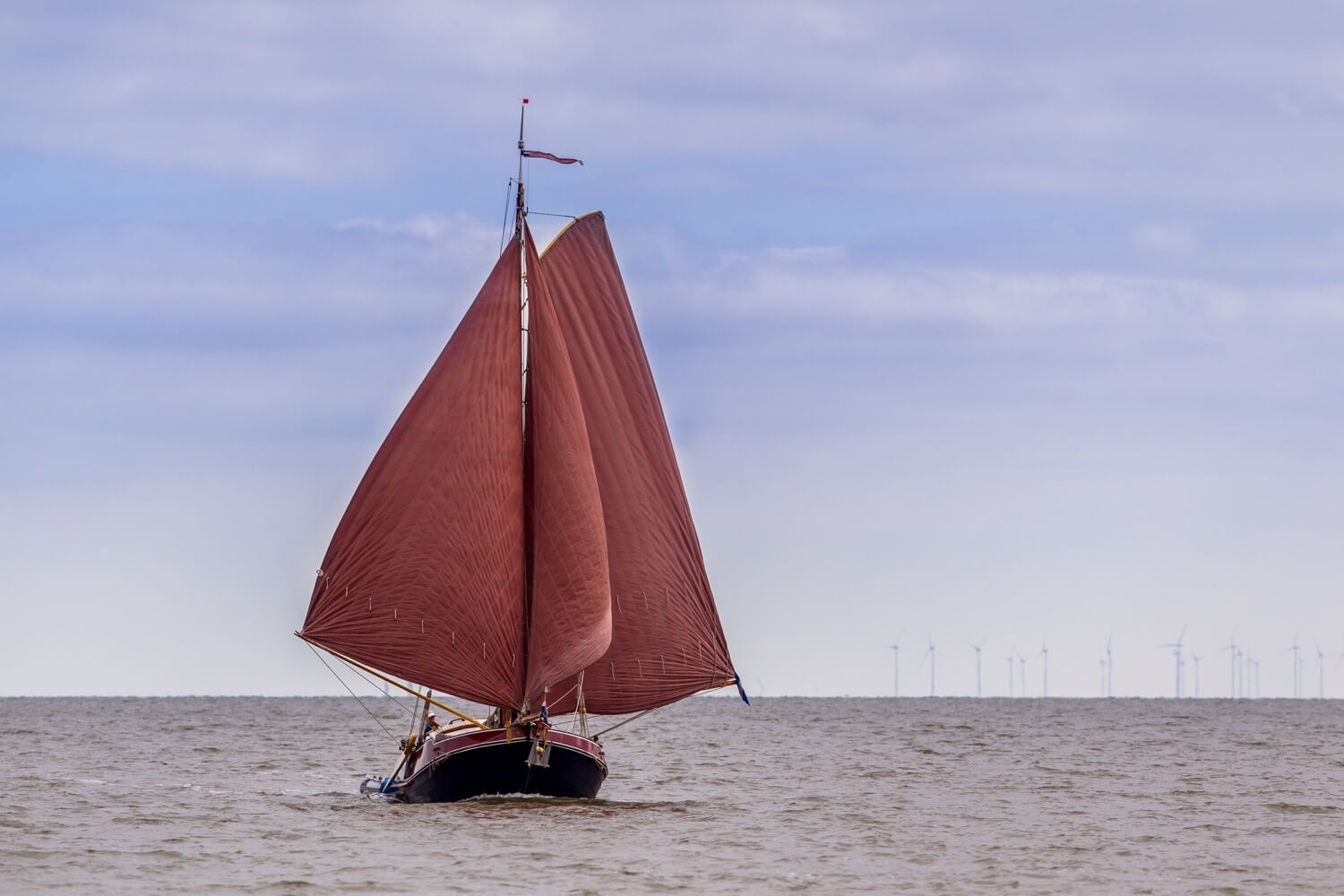
However, everybody has his or her own preferences, and you don't have to agree with me (although I find that hard to believe).
If you can resist the temptation to leave the topsails out of the equation, the gaff rig is really easy to sail. Although people tend to assume gaff rigs aren't meant to be sailed alone, I have, and pretty successfully uneventful .
But I repeat: you should resist the usage of topsails (go bald, as they say). The topsails add a whole lot of work, and the extra pain may outweigh any benefits you get from sailing this rig. Luckily, the solution is pretty simple: just don't fly the topsails.
However, if you get yourself an 'authentic' gaff rig, all of this doesn't really count. Those were built to be operated by small crews of 5-7 people, and they have no winches and rail. So it will be actually more work to sail it by yourself. Modern gaffs will typically fix these issues.
Hoisting the main requires a bit more effort. It's a bit slower to operate, sure, but as there are a lot less moving parts, it's easy to understand and get the hang of it. Which brings me to my next point.
The gaff rig is a bit What You See Is What You Get : there are no intricacies and because of the reduced strain on ... everything, it might be a very good starter rig to learn to sail.
Thanks to reduced strain on the standing rigging and mast, a lower center of gravity (which reduces heel) and the tendency of the gaff to sag to leeward, you could say the rig is a bit safer than the Bermuda rig.
"As the boat heels to a squall, the sagging gaff lets much of the force of the wind escape harmlessly over the top." Practical Boat Owner, No 330 June 1994 .
A small disclaimer: this only goes for modern gaff rigs that are well-built and well-designed. Everything else goes of the table. While a Bermuda rig has better windward performance, the gaff rig actually performs really well with tides and light winds.
I don't know about you, but I'm not a competitive sailor by any means. I only sail with fair weather. Add to that a little bit of tide - in those circumstances, a gaff rig is probably the better option.
The Bermuda rig is definitely the better choice for speed, maneuverability, and tacking upwind. While I like those characteristics, my life tends to be a lot less cinematic than I like to believe.
"A gaff rigged boat will perform incredibly well, in many cases besting the performance of a high aspect ratio Marconi rigged boat." Michael Kasten at KastenMarine.com
The gaff rig absolutely has disadvantages as well, and I thought it'd be fair to briefly mention the most important ones below.
Windward performance can be subpar
The gaff rig is notorious for louse windward performance, and it's true: the Bermuda rig will outperform the gaff rig - especially on a hard beat to windward. However, it's a small price to pay for the ease of use and simpler maintenance you get in return.
Reefing can be more dangerous with a gaff
You have to remember that you're carrying a large second boom, which is right at head-height when putting in a reef. You don't want to be there when the wind catches it.
Parts for the Marconi Rig may be more readily available
Since Bermuda sloops are so incredibly popular, parts may be more widely available and may be cheaper as well. It's my guess that problem-solving on a gaff rig is easier though, since you can get away with more MacGyver-type solutions.
Using the topsail can be a pain
We touched on this, but I think it's important to mention again, since it can really be a deal-breaker regarding ease of use.
I'm by no means an expert, which is why I have added some great sources to read on, by people who know a lot more about building sailboats than I do. I encourage you to read on and learn more before choosing your next rig.
That being said, there's a lot to be said for the gaff rig. It's beautiful, classic - but it also performs really well if set up correctly. It's not at all obvious that the Marconi rig is superior in all ways. It really depends on your sailing circumstances.
So now you have a great overview of the things to consider when choosing a rig type. If you want to read about other rig types, make sure to check out some of the other articles below.
Aren’t gaff sails cheaper per m2 to buy. I imagine it is simpler since there is not so much change in camber as there is with a triangular sail?
Great breakdown. Many years ago I sailed both gaff and Bermuda rigs and gaff rigs have always held a special spot in my heart. I wonder if you might compare a gaff schooner rig to a ketch? That adds an extra dimension to the comparison.
Can the gaf be used to hoist cargo on board?
Some examples of modern Gaffers would be useful - I assumed the Cornish Crabber would be modern rather than old!
“Cornish Crabbers” is an English company that build a range of trad looking GRP boats up to around 30ft, mostly gaff rigged. The original 24ft Cornish Crabber started life in the 80’s with plywood hulls, but was eventually converted to full GRP hulls. Details here: https://www.cornishcrabbers.co.uk Very nice looking boats but rather cramped and expensive.
I have a traditional 24ft gaff cutter that I love and agree with much of what Shawn writes. However one disadvantage he doesn’t mention is the challenge of gybing with running backstays in a fresh wind, especially if single or short-handed. I also would have classed the Cornish Crabber as a modern gaffer. A previous 27ft timber gaffer I owned had alloy spars and a topsail with its own spar, again alloy, and a jackyard. I often set it singlehanded, and found it gave a major performance boost in light to moderate conditions.
From personal experience, sailing Gaff rigged traditional yachts (without engines) on the Norfolk Broads in UK - i think a real plus point of Gaff over Bermuda [for inland river sailing, through raised riverbanks & trees], is that the centre of effort is higher up, so you can catch more of the available wind….
You also have increased flexibility with how you can set-up the sail, and adjust it’s shape to suit your needs:
Leave a comment
You may also like, 15 surprising benefits of a ketch rig (and 7 cons).
If you're trying to figure out whether the ketch rig is for you, there are a couple of important factors to consider. In this article, I'll sum up the most …

Guide to Understanding Sail Rig Types (with Pictures)

The Ultimate Guide to Sail Types and Rigs (with Pictures)

17 Sailboat Types Explained: How To Recognize Them

Different Types of Sailing and Racing Explained
Own your first boat within a year on any budget.
A sailboat doesn't have to be expensive if you know what you're doing. If you want to learn how to make your sailing dream reality within a year, leave your email and I'll send you free updates . I don't like spam - I will only send helpful content.
Ready to Own Your First Boat?
Just tell us the best email address to send your tips to:

Learn How To Rig a Gaff Rig Sailboat – A Step-by-Step Guide
Alex Morgan
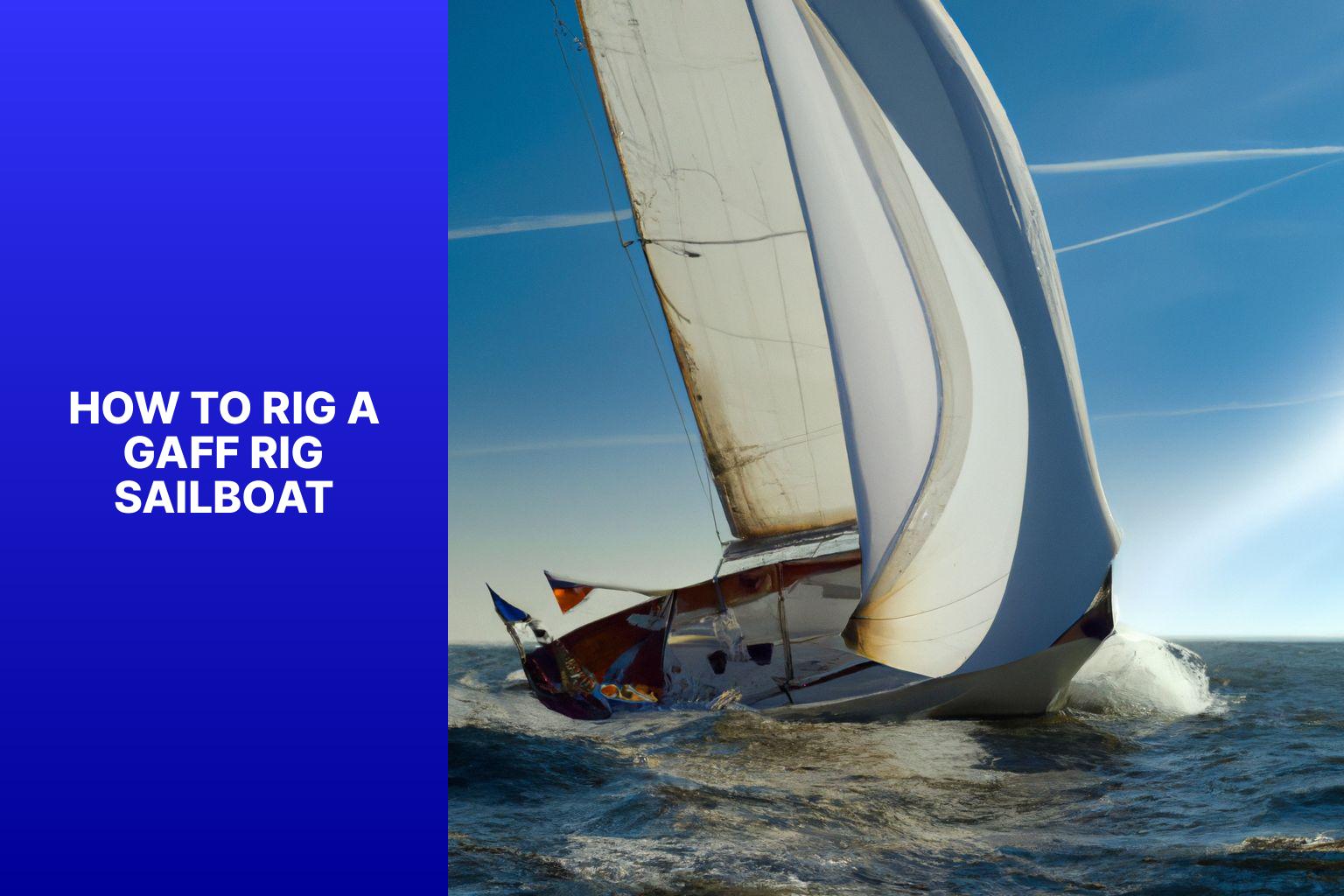
Rigging a gaff rig sailboat is essential for anyone who wants to embark on a sailing adventure with this unique type of sailboat. Gaff rig sailboats are known for their traditional design and distinctive triangular shape that sets them apart from other sailboats.
To properly rig a gaff rig sailboat, it is crucial to understand the different components involved, such as the gaff spar , boom , sails , and rigging . In this comprehensive guide, we will walk through the step-by-step process of rigging a gaff rig sailboat, including preparing the spar and sails, hoisting the mainsail, attaching the boom and headsail, and setting the rigging. we will provide valuable tips for rigging and sailing a gaff rig sailboat, including maintaining proper tension, adjusting the gaff spar and boom, and understanding sail trim. By following this guide, you will be able to rig your gaff rig sailboat effectively and set sail with confidence.
Key takeaway:
- Introduction to Gaff Rig Sailboats: Gaff rig sailboats are a type of sailboat that utilize a gaff spar, boom, sails, and rigging to operate.
- Components of a Gaff Rig Sailboat: The gaff spar, boom, sails, and rigging are all vital components that make up a gaff rig sailboat.
- Step-by-Step Guide: How to Rig a Gaff Rig Sailboat: Rigging a gaff rig sailboat involves preparing the spar and sails, hoisting the mainsail, attaching the boom and headsail, and setting the rigging.
Components of a Gaff Rig Sailboat
Get to know the key components that make up a gaff rig sailboat . From the sturdy gaff spar to the versatile boom , the beautifully crafted sails to the intricate rigging , each sub-section of this section unravels the essence of a gaff rig sailboat. Explore the intricate details and learn about the important role these components play in the smooth sailing of this classic rigging system.
The Gaff Spar is a vital component of a Gaff Rig Sailboat , providing support to the sail. It is a pole attached to the mast and extends horizontally towards the stern of the boat. The Gaff Spar has a significant role in controlling the shape and position of the sail, impacting the boat’s performance.
The Gaff Spar consists of several parts that contribute to its functionality. These include the jaws , which secure it to the mast, and the peak halyard , used to raise and lower the gaff. The throat halyard controls the position of the gaff on the mast.
When rigging a Gaff Spar, proper tension and alignment are necessary. The jaws should be securely attached to the mast, and the halyards should be adjusted to achieve the desired sail shape. Maintaining the correct tension throughout the sail is crucial for optimal performance.
Fun fact: The Gaff Spar is a distinctive feature of Gaff Rig Sailboats and allows for a larger sail area, making them powerful and efficient vessels.
The boom is a vital part of a gaff rig sailboat. It is a horizontal pole that extends from the mast and supports the lower edge of the mainsail. Here are some important facts about the boom:
Function: The boom controls the shape and angle of the mainsail, maintains tension in the sail, and allows for effective maneuvering of the boat.
Construction: Booms are made of aluminum or wood, depending on the sailboat type. They are designed to be sturdy yet lightweight to withstand wind forces.
Attachment: The boom is attached to one end of the mast and can pivot freely. The other end connects to the mainsail, allowing it to move as the sail is raised, lowered, or adjusted.
Manipulation: Sailors adjust the boom position using the boom vang, a device that controls tension and height. Adjusting the boom optimizes sail shape and trim, enhancing the boat’s performance.
Safety: Caution is necessary when near the boom to avoid collisions. Sailors should be mindful of their position and the boom’s movement during tacking or gybing.
Fact: The boom in a gaff rig sailboat aids in optimizing sail shape and trim, improving performance and maneuverability on the water.
The sails are essential components of a gaff rig sailboat. There are two main types of sails used in this rig: the mainsail and the headsail .
The mainsail is the largest sail and is attached to the gaff spar. It captures the wind and propels the boat forward. The mainsail can be adjusted to control the sail’s angle and shape , optimizing performance.
The headsail , also known as the foresail , is located forward of the mast. It complements the mainsail by providing additional power and stability. The headsail can be adjusted to control the wind captured, allowing sailors to adapt to different conditions.
Both sails are crucial for maneuvering and controlling the gaff rig sailboat. They are designed and crafted for efficiency and performance on the water. Sail trim , adjusting the position and tension of the sails, is vital for speed and handling.
Regularly inspect and maintain the sails to ensure a successful sailing experience. Check for wear or damage and make necessary repairs or replacements. Proper care and attention will enhance the sails’ longevity and the overall sailing experience.
Rigging a gaff rig sailboat involves several steps to ensure the sails and rigging are properly set up for smooth sailing. Here is a step-by-step guide:
1. Check the spar and sails for damage or wear. Attach the gaff spar securely to the mast.
2. Hoist the mainsail by attaching the halyard to the head of the sail and raising it up the mast. Secure the halyard.
3. Connect the boom to the mast and secure it using the boom vang.
4. Attach the headsail by connecting the halyard to the head of the sail and hoisting it up the forestay.
5. Adjust the shrouds and stays to set the rigging. Check for proper tension for stability and support.
6. Attach the halyards and sheets to the sail and boom, respectively. Ensure they are properly tensioned for sail control.
Maintaining proper tension in the rigging is crucial for stability and performance. Regularly check and adjust the tension as needed. Correctly adjusting the gaff spar and boom is important for sail control and achieving the desired sail shape and performance. Understanding sail trim is essential for optimizing the performance of a gaff rig sailboat. Experiment with different sail positions to find the most efficient settings for various wind conditions.
Step-by-Step Guide: How to Rig a Gaff Rig Sailboat
Get ready to set sail with this step-by-step guide on rigging a gaff rig sailboat. From preparing the spar and sails to hoisting the mainsail, attaching the boom and headsail, and setting the rigging – we’ll walk you through each crucial step. Whether you’re a seasoned sailor or a curious novice, these tips will help you navigate the process smoothly and get you out on the water in no time. So grab your gear and let’s rig that sailboat!
Preparing the Spar and Sails
Preparing the Spar and Sails for rigging a gaff rig sailboat involves several crucial steps. It is essential to carefully inspect the spar for any signs of damage or wear, such as cracks , splits , or loose fittings. This thorough inspection ensures the safety and functionality of the sailboat.
Next, it is important to prepare the sails by laying them out on a clean surface and checking for any tears or holes . This step guarantees that the sails are in optimal condition for rigging.
To hoist the sails up the mast, it is necessary to attach the halyards securely. It is crucial to ensure that they are properly attached and free from any knots that could hinder the smooth hoisting process.
Controlling the angle and tension of the sails can be achieved by attaching the sheets . These sheets must be securely fastened and properly adjusted to maintain the desired sail position.
Another important attachment is the downhaul , which allows for controlling the shape of the sail. It is of utmost importance to securely attach and properly adjust the downhaul to ensure an optimal sailing experience.
Carefully check the rigging , including the shrouds and stays , for any signs of damage or wear. It is crucial to properly tension and securely fasten all rigging components to guarantee the sailboat’s stability.
Inspecting the sail track and slides on the mast for cleanliness and obstructions is another essential step. This inspection ensures that the sails can smoothly and efficiently slide along the mast during rigging.
Once these steps have been completed, you will be fully prepared to continue rigging your gaff rig sailboat. Always remember to follow the manufacturer’s instructions and utilize proper sailing techniques for a safe and enjoyable experience on the water.
Hoisting the Mainsail
To hoist the mainsail on a gaff rig sailboat, follow these steps:
- Attach the halyard to the head of the mainsail .
- Begin hoisting the mainsail by pulling on the halyard.
- Keep an eye on the luff to ensure proper alignment.
- Continue hoisting the mainsail to the desired height.
- Secure the halyard once the mainsail is fully hoisted.
Suggestions for hoisting the mainsail :
- Take your time and be careful.
- Communicate with your crew members.
- Practice in calm weather conditions first.
- Regularly inspect rigging components for good condition and maintenance.
Remember, hoisting the mainsail is important for preparing the sailboat. Follow the steps carefully and stay safe on the water.
Attaching the Boom and Headsail
To attach the boom and headsail on a gaff rig sailboat, follow these steps:
1. Position the boom: Place the boom on the mast and slide it toward the aft end until it aligns with the jaws of the gaff spar.
2. Secure the boom: Attach the boom to the jaws of the gaff spar using a stainless-steel pin or bolt. Ensure it is tightly secured to prevent movement during sailing.
3. Attach the headsail: Take the headsail and attach it to the forestay connected to the masthead. Use hanks or clips on the headsail to fasten it securely to the forestay. Ensure all attachments are secure.
4. Adjust the tension: Check the tension of the headsail by gently pulling on the sheets. The headsail should be taut but not overly tight. Make necessary adjustments for the desired tension.
5. Inspect connections: Double-check all connections and fastenings to ensure they are secure. Confirm that the boom is properly attached to the gaff spar and the headsail is securely fastened to the forestay.
By following these steps, you can successfully attach the boom and headsail on a gaff rig sailboat, giving you a smooth and efficient sailing experience.
Setting the Rigging
To properly set the rigging on a gaff rig sailboat, follow these steps:
1. Adjust the shrouds and stays: Ensure that these lines are properly tensioned and secure. They support the mast and maintain its position.
2. Rig the halyards and sheets: Attach the halyards to the sails and run them through the appropriate blocks or pulleys. The halyards hoist and control the sails. The sheets control the angle and tension of the sails.
Setting the rigging is critical for rigging a gaff rig sailboat. The proper tension and alignment of the shrouds and stays ensure mast stability and performance. Rigging the halyards and sheets correctly is essential for controlling the sails and maneuvering the boat effectively. By following these steps, you can ensure that your gaff rig sailboat is properly rigged and ready for a successful sailing experience.
Gaff rig sailboats have a rich history dating back to the 17th century. They were commonly used on working sailboats and fishing vessels due to their versatility and efficiency. The design features a large, fore-and-aft mainsail supported by a gaff spar. This rigging allowed sailors to navigate different wind conditions and made these boats well-suited for hauling cargo and coastal trading. Although modern sailboat designs have evolved, gaff rig sailboats are still admired for their aesthetic appeal and nostalgic charm. Many sailing enthusiasts still enjoy the unique experience of setting the rigging and sailing a gaff rig sailboat, connecting with a bygone era of maritime history.
Tips for Rigging and Sailing a Gaff Rig Sailboat
Get ready to set sail with these expert tips for rigging and sailing a gaff rig sailboat . We’ll dive into the secrets of maintaining proper tension, adjusting the gaff spar and boom , and understanding sail trim . Discover the key elements to make your gaff rig sailboat glide effortlessly through the water and experience the thrill of harnessing the wind’s power. So, grab your ropes and let’s embark on an exciting journey into the world of gaff rig sailing !
Maintaining Proper Tension
Maintaining proper tension is crucial for the performance and safety of a gaff rig sailboat. To achieve this, follow these steps:
1. Regularly inspect the rigging for any signs of wear or damage, including the shrouds, stays, halyards, and sheets.
2. Adjust the rigging tension as needed to ensure the integrity of the rig and prevent excessive movement.
3. To check the tension of the shrouds and stays, gently apply pressure to the mast and observe the deflection. The mast should have a slight bend .
4. If the tension is too loose , tighten the shrouds and stays gradually using an appropriate tensioning device. Remember to distribute equal tension on both sides.
5. On the other hand, if the tension is too tight , release some tension by turning the tensioning device counterclockwise.
6. Pay close attention to the tension of the halyards and sheets. They should support the sails without hindering their movement.
7. Regularly inspect the tension of the gaff spar and boom, ensuring they are both secure and properly tensioned to control the shape of the sail.
8. Adjust the tension of the gaff spar and boom as necessary to achieve optimal sail trim and performance .
9. Maintain proper tension throughout your sailing trip and make adjustments as the conditions change.
By following these steps, you can ensure that your gaff rig sailboat maintains the proper tension for a safe and enjoyable sailing experience.
Adjusting the Gaff Spar and Boom
Adjusting the gaff spar and boom is imperative when rigging a gaff rig sailboat . It is crucial for ensuring the proper sail shape, stability, and control while sailing.
To begin, check the alignment by making sure the gaff spar is parallel and centered with the mast.
Next, tighten the gaff jaws by securely fastening them around the mast. This will prevent any movement during sailing.
Then, attach the throat halyard to the throat of the gaff spar . This will allow you to control the height and angle of the mainsail.
Fine-tune the tension of the throat halyard to achieve the desired sail shape. More tension will raise the gaff spar , while less tension will lower it.
Securely attach the peak halyard to the peak of the gaff spar . This will give you control over the leech tension and the overall shape of the mainsail.
Adjust the tension of the peak halyard to achieve optimal sail shape. Increasing the tension will increase leech tension and flatten the sail, while decreasing the tension will allow the sail to fill out more.
Always check the boom position to ensure it is properly attached to the mast and gaff spar . It should be parallel to the deck and positioned at the desired height.
To control the twist in the mainsail, modify the boom angle. Higher boom angles will increase twist, while lower angles will decrease it.
Increase the tension in the boom vang to control the downward force on the boom. This will stabilize the mainsail and prevent excessive leech flutter.
By following these steps and making necessary adjustments to the gaff spar and boom , you can optimize the performance and maneuverability of your gaff rig sailboat.
Understanding Sail Trim
Understanding sail trim is crucial for sailing a gaff rig sailboat effectively. Sail trim optimizes sail performance and maximizes speed and efficiency. Consider the following aspects of sail trim:
1. Adjusting the sails: Properly understand sail trim and set the sails for efficient propulsion. Keep the sails trimmed according to wind direction and strength. Well-trimmed mainsail and headsail provide optimal power and balance.
2. Controlling twist: Understanding sail trim helps maintain the desired amount of twist based on wind conditions. Too much twist reduces efficiency, while too little twist causes excessive heeling. Adjust sheets and halyards to control twist effectively.
3. Balancing the boat: Proficient sail trim helps maintain balance and stability while sailing. Understand how to adjust the sails to evenly distribute forces, minimizing weather helm or lee helm. Balanced boats sail more efficiently and are easier to control.
4. Monitoring sail shape: Pay attention to sail shape and understand how sail trim affects it. The sails should have a smooth, aerodynamic shape without excessive wrinkles or flapping. Adjust tension on halyards, sheets, and outhaul to achieve the desired sail shape.
5. Reacting to changing conditions: Understanding sail trim means being attentive to shifts in wind direction and strength. Make necessary adjustments promptly to optimize performance.
Understanding sail trim comes with experience. Regular practice and observation of how adjustments affect boat performance enhance sail trim proficiency. By cultivating this understanding, you can improve efficiency and enjoyment of sailing a gaff rig sailboat .
Facts about How To Rig A Gaff Rig Sailboat:
Some Facts About How To Rig A Gaff Rig Sailboat:
- ✅ Modern gaff rig sailboats offer practicality and simplicity, with easier trailing and rigging compared to Bermudan rigs. (Source: Classic Boat)
- ✅ The lower center of effort of gaff rigs allows for lighter lifting keels and easier downwind performance. (Source: Classic Boat)
- ✅ Trimming a gaffer can be challenging and rewarding, with boom angle and jib tension being important factors in optimizing performance. (Source: PBO)
- ✅ Gaff rig owners often prefer cream or white sails for better visibility and a classic appearance. (Source: PBO)
- ✅ Sewing the ends of two ropes together using sailmaker’s twine allows for easy replacement of worn or damaged halyards on gaff-rigged sailboats. (Source: PBO)
Frequently Asked Questions
1. how do i rig a gaff rigged sailboat with multiple blocks.
Rigging a gaff rigged sailboat with multiple blocks can seem daunting at first, but the process is actually simple if both ends of the halyards are accessible from the deck. By sewing the ends of the two ropes together using sailmaker’s twine, you can create a smooth joint that can be easily pulled through the blocks. Simply pull on the free end of the old halyard, and the new one will automatically reeve.
2. What are the advantages of using lightweight synthetics in gaff rigging?
Using lightweight synthetics in gaff rigging offers several advantages. These materials are not only lighter in weight, but they also have increased strength and durability. They are less prone to stretching and UV degradation, providing a longer lifespan for your rigging. Lightweight synthetics can improve upwind efficiency and downwind performance, resulting in a smoother sailing experience.
3. Why are gaff rigs preferred in heavier winds?
Gaff rigs are often preferred in heavier winds due to their lower rig tension and the use of high peak gaffs. The lower center of effort and shorter spars of gaff rigs allow for better balance and easier management of sail area in strong winds. This results in less heel and a more comfortable sail, allowing sailors to maintain control and stability even in challenging conditions.
4. How are gaff rigs different from bermuda rigs?
Gaff rigs and bermuda rigs differ in their sail configurations and rigging. Gaff rigs use a spar, or strong pole, on top of the sail, while bermuda rigs have a triangular mainsail. Gaff rigs were commonly used in the past and offer a classic appearance, while bermuda rigs are more modern and efficient. Bermuda rigs have become dominant in the sailing scene, but gaff rigs are still appreciated by enthusiasts for their unique sailing capabilities and timeless charm.
5. What are some modern conveniences in gaff-rigged sailboats?
Modern gaff-rigged sailboats, also known as gaffers, offer a blend of classic style designs and modern conveniences. These boats are designed for practicality and simplicity, providing easier trailing and rigging compared to bermudan rigs. They often feature improved performance, with upgrades such as carbon spars and modern hardware. Gaffers also have lighter lifting keels and better downwind performance thanks to their lower center of effort, making them suitable for a variety of sailing conditions.
6. How do I replace an old wick in a paraffin lamp on a gaff-rigged vessel?
Replacing an old wick in a paraffin lamp on a gaff-rigged vessel is a simple process. Just like replacing a worn or damaged halyard, you can use a technique called sewing. Stitch the ends of the new wick together using light sailmakers twine, creating a smooth joint. Then, pull out the old wick by pulling on the free end, and the new one will automatically be pulled through. This technique can be used both on a gaff-rigged vessel and for other purposes, such as replacing a halyard.
About the author
Leave a Reply Cancel reply
Your email address will not be published. Required fields are marked *
Save my name, email, and website in this browser for the next time I comment.
Latest posts

The history of sailing – from ancient times to modern adventures
History of Sailing Sailing is a time-honored tradition that has evolved over millennia, from its humble beginnings as a means of transportation to a beloved modern-day recreational activity. The history of sailing is a fascinating journey that spans cultures and centuries, rich in innovation and adventure. In this article, we’ll explore the remarkable evolution of…

Sailing Solo: Adventures and Challenges of Single-Handed Sailing
Solo Sailing Sailing has always been a pursuit of freedom, adventure, and self-discovery. While sailing with a crew is a fantastic experience, there’s a unique allure to sailing solo – just you, the wind, and the open sea. Single-handed sailing, as it’s often called, is a journey of self-reliance, resilience, and the ultimate test of…

Sustainable Sailing: Eco-Friendly Practices on the boat
Eco Friendly Sailing Sailing is an exhilarating and timeless way to explore the beauty of the open water, but it’s important to remember that our oceans and environment need our protection. Sustainable sailing, which involves eco-friendly practices and mindful decision-making, allows sailors to enjoy their adventures while minimizing their impact on the environment. In this…

- Find A School
- Certifications
- North U Sail Trim
- Inside Sailing with Peter Isler
- Docking Made Easy
- Study Quizzes
- Bite-sized Lessons
- Fun Quizzes
- Sailing Challenge
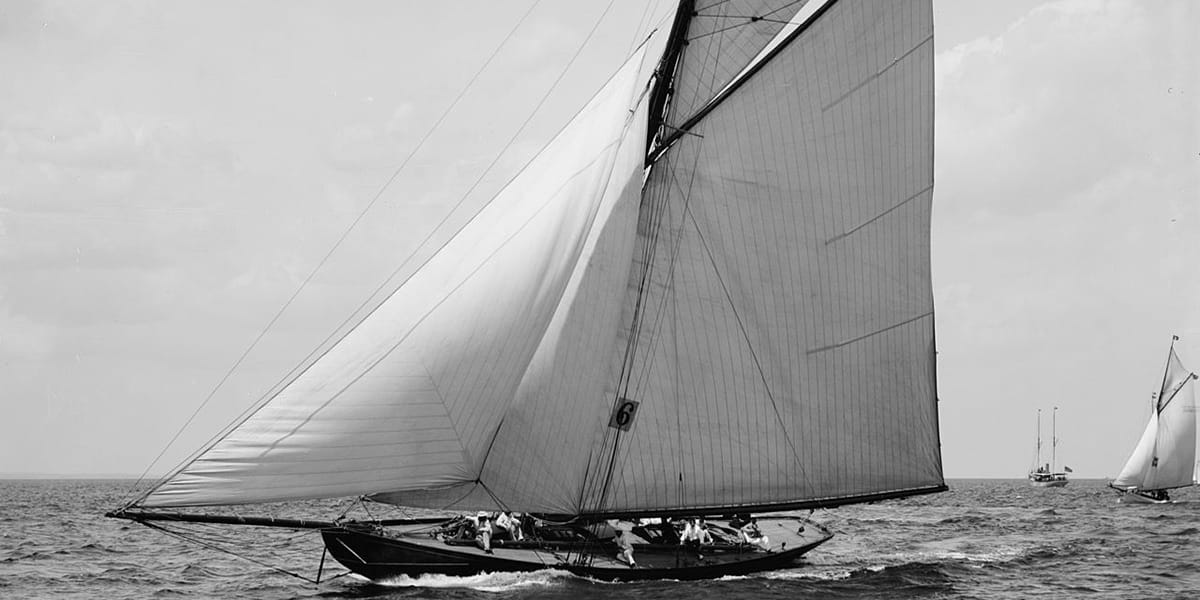
What’s in a Rig? The Gaff Rig
By: Pat Reynolds Sailboat Rigs , Sailboats
What’s in a Rig Series #6 – Gaff Rig
What’s a gaff rig? Well, first… what’s a gaff? A gaff is a spar, or a strong pole. A gaff rig employs a spar on the top of the sail and typically other sails can be set in conjunction with that mainsail with the gaff. Often, on the smaller, non tall ship, gaff rigs, there will be a small triangular sail that fits between the main and the mast like a puzzle piece – this is the topsail.
The gaff rig was the standard manner of rigging a sailboat a century ago and before. The thinking at that time had to do primarily with the ability to manage sail area. The sails weren’t made of the lightweight synthetics of today and there was solid logic involved in dividing the sail plan into pieces for the purposes of balancing and reefing in strong winds. Like today, sailors wanted horsepower via sail area and fractioned rigs allowed skippers to also manage it more easily.
These rigs weren’t so wonderful upwind, so when the bermuda rig was introduced, with their efficiency and simplicity, the gaff rig fell out of favor. Modern sloops dominated the scene and continue to do so, but during the 1960s, folks began to say, “actually gaff rigs are kind of cool,” and there was something of a resurgence based on a love for history and the beauty of the rig.
Today, gaff rigs are still around, sailed by sailors who love what they represent and some that swear by their sailing capabilities. Like the ketch rig, gaff rig lovers will say that the configuration produces less heel, a more comfortable sail, better balance and more choices for reefing in heavier winds. They might also speak of the practicality of being out at sea and having the ability to make repairs to a a part of the rig with plenty of rig still intact and operational.
However, the gaff rig’s greatest pull is probably its classic appearance. There is something so undeniably dignified and stalwart about a fully rigged, gaff-rigged sailboat making its way. They are living reminders of where technology was and the importance of solid craftsmanship that existed at that time. They exude beauty and carry with them a spirit that is unique and distinct.
What's in a Rig Series:

Related Posts:

- Learn To Sail
- Mobile Apps
- Online Courses
- Upcoming Courses
- Sailor Resources
- ASA Log Book
- Bite Sized Lessons
- Knots Made Easy
- Catamaran Challenge
- Sailing Vacations
- Sailing Cruises
- Charter Resources
- International Proficiency Certificate
- Find A Charter
- All Articles
- Sailing Tips
- Sailing Terms
- Destinations
- Environmental
- Initiatives
- Instructor Resources
- Become An Instructor
- Become An ASA School
- Member / Instructor Login
- Affiliate Login

Educational
“hold on the peak, up on the throat” let’s explore the gaff rig..
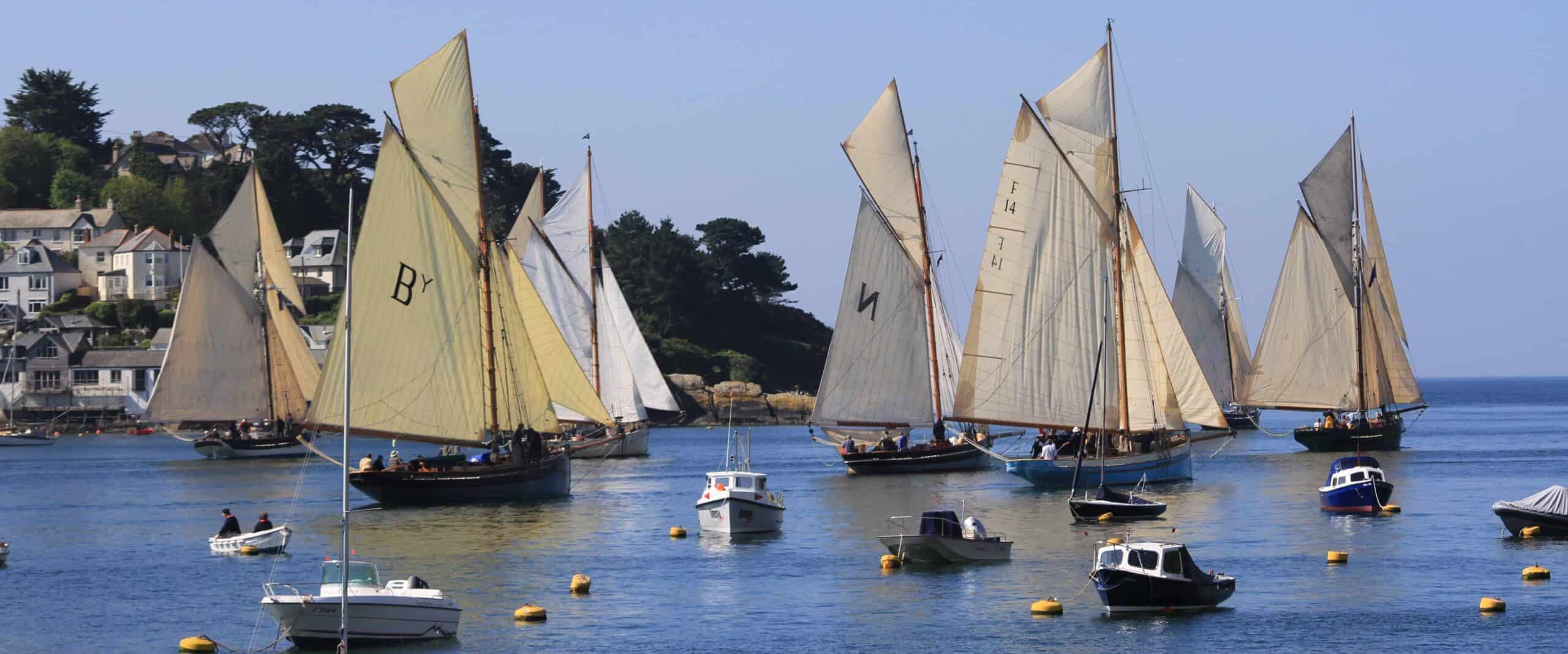
When you think of a ‘traditional’ sailing ship, many people will picture something from a Pirates of the Caribbean film. A big, old galleon with several billowing square-shaped sails flying one on top another. You may have noticed however that most of our Classic Sailing fleet (at the moment!) don’t quite fit that image. The majority of our ships are Gaff rigged. Gaff rigged sailing vessels, with their distinctive ‘4-cornered-but-triangular-shaped’ sails and rich history, have been an integral part of maritime culture for centuries. This style of rigging has evolved from older sail designs, each adaptation refining its performance and versatility. The gaff rig stands as a testament to the ingenuity of seafarers, and its impact on sailing is undeniable. In this article, we’ll take a peek at the fascinating world of gaff rigged vessels, exploring their evolution, unique features, and notable examples.
Of course we can’t write about gaffer’s without pointing you towards Tom Cunliffe’s brilliant book, ‘Hand, Reef and Steer’ and also the Association for Gaff Rig Sailing (OGA) for further reading and resources.
Evolution from Older Rigs
The gaff rig’s origins can be traced back through the centuries, emerging as a refinement of the older square rig and spritsail designs. It introduced the ‘gaff’, a wooden spar at the top of the sail extending diagonally from the mast, allowing for a larger sail area and improved control. This innovation enabled sailors to harness the wind more efficiently, enhancing manoeuvrability and overall performance.


Differences from Square Rigged Ships
One key distinction between gaff rigged vessels and their square rigged counterparts is the positioning of the sails. Square rigs feature square-shaped sails that are attached perpendicular to the mast. Gaff rigged vessels utilise triangular sails suspended from the gaff. This configuration offers greater control over sail shape and allows for efficient tacking into the wind.
Advantages and Impact
The gaff rig’s ability to sail closer to the wind than square sailed ships was a revolutionary advancement in sail technology. This capability not only expedited voyages but also impacted global trade, exploration, and naval warfare. Gaff rigged vessels became favoured choices for coastal and short-haul journeys, as they could navigate shallow waters and challenging coastlines with agility.
Anatomy of a Gaff Sail
A typical gaff sail comprises several components, including the mast, gaff, boom, and various lines and ropes. The mast serves as the vertical support, while the gaff is the diagonal spar that supports the head of the sail. The boom, a horizontal spar attached to the foot of the sail, helps control the position and shape of the sail and manage its angle to the wind.
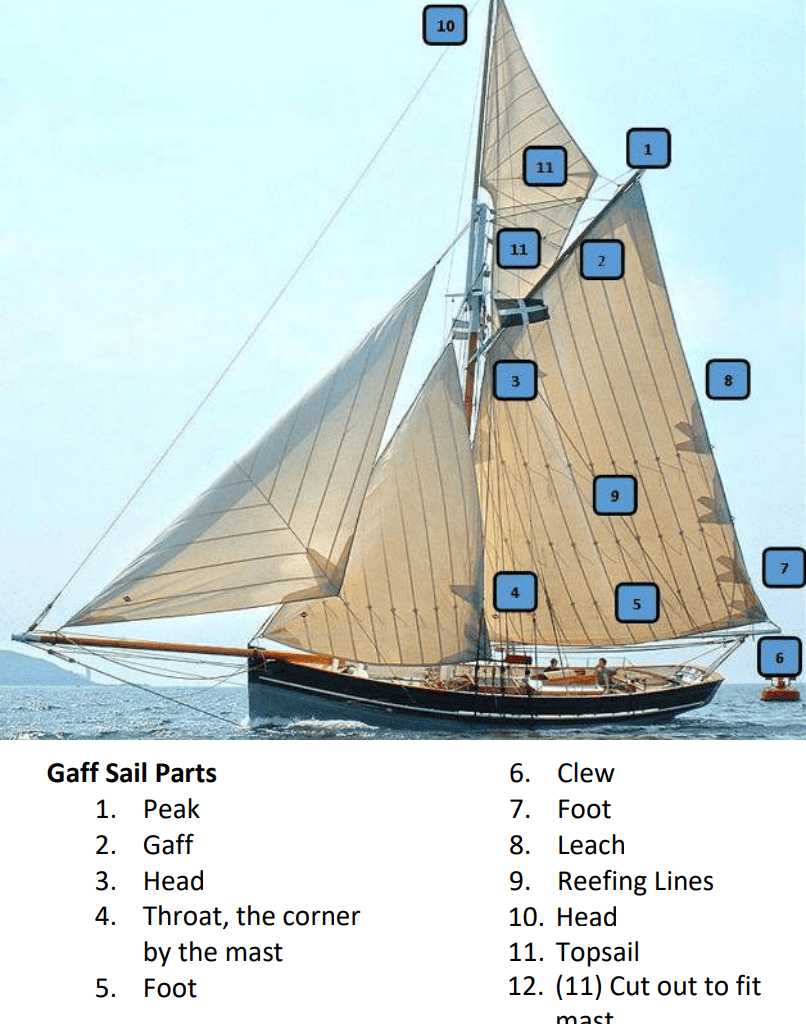
Multiple Halyards and Line Control
Gaff rigged vessels commonly employ two halyards instead of one. The throat halyard raises the forward end of the gaff, while the peak halyard raises the aft end. This dual halyard system offers greater control over the sail’s shape and tension. The gaff can be raised or lowered as needed, enabling adjustments for various wind conditions. There is a knack to raising a gaff sail. You may hear the mate or skipper asking for one of the halyards to hauled and the other held as you and your fellow sailiors are ‘sweating’ up the sail!

Gaffer’s in the Classic Sailing Fleet
Linden Pilgrim Provident Santa Maria Manuela Tallulah Tecla In conclusion, gaff rigged sailing vessels have a storied past that stretches back centuries. Evolving from older rig designs, gaff rigs introduced innovations that improved sailing performance and revolutionized maritime exploration and trade. As you explore the maritime world, keep an eye out for these majestic vessels and marvel at the legacy they carry.
Blog search
Latest Posts
04/24 Inspiration
Great Summer Voyages
02/28 Educational
2024 – Classic Sailing’s Year of Skills: Confident Crew
02/01 Boat building
2024: Classic Sailing’s Year of Skills! It’s not just sailing, you know!
01/14 Inspiration
Turning the Tide on Blue Monday
05/17 Book Reviews
Cargo of Hope
05/02 Vessel News
Announcing the 18th Annual Classic Sailing Pilot Cutter Review for 2024
Lost Containers
Blue Machine – a book review.
More Stories

24/04 Inspiration
Great Summer Voyages Sail the coastal waters of Cornwall, Isles of Scilly, Devon, Scotland, the Baltic, Mediterranean, and Brittany on tall ship voyages ranging
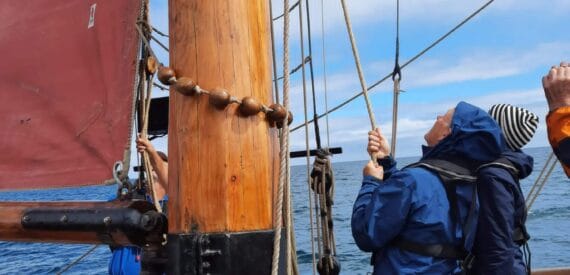
28/02 Educational
Throughout 2024, we’re shining the spotlight on the various ways our customers get more with a Classic Sailing booking. Sailing on a traditional vessel

01/02 Boat building
Throughout 2024, we’re shining the spotlight on the various ways our customers get more with a Classic Sailing booking. There are many physical and

14/01 Inspiration
Turning the Tide on Blue Monday Blue Monday, marked on 15th January 2024, is here again. Many of us find ourselves caught in the

17/05 Book Reviews
Voyages of Hope: The Story of Vega The story of the voyages of Vega from 1892 to the present day. This tale concentrates on

02/05 Vessel News
Pilot Cutter Review Sailing in Fowey and St Mawes Cornwall 30th May to 2nd June 2024 We are excited to announce that the 18th
"One detail which may be of interest to you and your readers is that many of the gaff rigs that I've specified make use of a single halyard for the gaff. It is made possible by the relatively short gaffs that I prefer, arranged much like the gaff rigs on the Baltimore Pilot Vessels of the last century."
"As I have discovered on my own 34 foot gaff schooner EMERALD, with short gaffs there is no need for a peak halyard. Luff tension is adjusted at the gooseneck. The benefit is to simplify the rig, to always keep the gaff in the same attitude while raising and lowering, to increase luff length for better windward sailing, to reduce weight aloft, and to eliminate those pesky tops'ls." "On a schooner I do like to use a fisherman tops'l, as it provides enough area to be of excellent use. The gaff tops'ls however are more trouble than they are worth (IMHO)." Michael Kasten , November 20, 2000
Gaff Rig Sailboat: A Classic and Timeless Sailing Experience
by Emma Sullivan | Aug 14, 2023 | Sailboat Gear and Equipment

== Short answer gaff rig sailboat: == A gaff rig sailboat is a type of sailing vessel that features a specific rigging system consisting of a four-sided fore-and-aft sail called a gaff sail. This traditional design offers numerous advantages including simplicity, ease of handling, and excellent downwind performance. Gaff rigged boats are commonly seen in traditional and recreational sailing settings.
Understanding the Gaff Rig Sailboat: A Comprehensive Guide
Sailing is truly a timeless pursuit that continues to captivate enthusiasts worldwide. Among the various types of sailboats, the gaff rig sailboat stands out as a unique and intriguing vessel. With its distinct mast and triangular sails, this traditional design is both awe-inspiring and efficient on the water. In this comprehensive guide, we delve into the key aspects of understanding and appreciating the gaff rig sailboat.
The Glory of Gaff Rig Sailboat Design
At first glance, a gaff rig sailboat immediately catches one’s eye with its striking visual appeal. Unlike modern sloop or cutter rigged boats, it proudly exhibits an imposing wooden or aluminum mast that slopes aft at an angle. Attached to this distinctive feature are two sets of sails – a larger mainsail and a smaller headsail.
These sails grant the gaff rig sailboat unparalleled gracefulness while sailing by providing superior power in light winds. Due to their relatively lower aspect ratio compared to other rigs, they generate increased lift, resulting in remarkable upwind performance. This makes the gaff rig not only aesthetically pleasing but also an excellent choice for those seeking both beauty and functionality on the water.
Advanced Maneuverability with Gaff Rig Sails
One advantageous feature of the gaff rig sailboat lies in its versatile sailing capabilities. The unique arrangement of sails allows skilled sailors to expertly trim each individual sail according to wind conditions – adding an extra layer of challenge for those looking to refine their skills.
Furthermore, unlike more modern rigs where adjustments may be limited by complex systems, controlling the sails on a gaff rig boat is simpler yet equally effective. By tweaking halyards and sheets with precision, sailors can achieve optimal balance between power and wind direction without compromising safety or maneuverability.
Embrace Tradition & Classic Seamanship Values
Beyond its exceptional performance characteristics, embracing a gaff rig sailboat allows sailors to immerse themselves in the rich history and traditions of sailing. The gaff rig ‘s roots can be traced back centuries, evoking a sense of nostalgia for a bygone era when wooden ships ruled the seas. Sailing enthusiasts who appreciate craftsmanship and classic seamanship values will undoubtedly find solace in the elegance and heritage of this design.
Furthermore, the charm of a wooden or classic looking gaff rig sailboat is sure to catch the attention of fellow mariners and onlookers alike. Owning such an awe-inspiring vessel not only grants pride but also serves as a conversation starter, connecting sailors with others who share their passion for the maritime world.
Maintenance & Practical Considerations
While we highlight the beauty and allure of the gaff rig sailboat, it is essential to consider practical aspects as well. Maintenance plays a vital role in preserving its splendor. Wooden masts demand regular varnishing or painting to protect against weathering, whereas aluminum masts require periodic inspection for corrosion.
Similarly, ensuring proper storage during off-seasons or inclement weather must be taken into account. Properly covering the boat and storing it in a dry area contributes significantly to prolonging its lifespan while minimizing potential damage caused by environmental factors.
In conclusion, understanding and appreciating the gaff rig sailboat involves recognizing its unique design features, advanced maneuverability potential, historical significance, and maintenance requirements. By delving into these aspects detailed above, aspiring gaff rig sailors can embark on a rewarding journey that combines tradition with timeless excellence on the water.
How to Rig a Gaff Sailboat: Step-by-Step Instructions
Sailing enthusiasts know that sailing on a gaff-rigged sailboat can be an exhilarating experience. The distinctive triangular shape of the gaff sail gives these boats a classic look and offers unique challenges when it comes to rigging. If you’re new to gaff sailboats or just need a refresher, this step-by-step guide will help you rig your vessel with ease.
Before we dive into the instructions, let’s quickly discuss what elements make up a gaff sailboat’s rigging . A typical gaff-rigged sailboat consists of four essential components: the mast, the boom, the gaff, and of course, the appropriately sized gaff sail itself. Understanding how these parts work together is crucial for successfully setting up your boat for sailing .
Step 1: Preparing Your Boat Start by ensuring that all necessary equipment and tools are readily available. You’ll need halyards (lines used to raise sails), sheets (lines used to control sails), cleats, blocks, shackles, and any other hardware specific to your boat ‘s rigging system. Inspect all lines for wear and tear, replacing any damaged ones before moving forward.
Step 2: Setting up the Mast Securely step your mast in its designated spot using proper supports or partners specifically designed for your boat ‘s mast setup. Make sure it is properly aligned and tightly fastened in place – giving it a gentle shake shouldn’t produce any wiggles! Check that all mast fittings are secure and functional.
Step 3: Attaching the Boom Attach one end of your boom securely onto its fitting at the base of the mast – usually located near deck level – using appropriate shackles or other connecting mechanisms provided by your boat’s manufacturer. Ensure that there is ample clearance around you while doing this step to avoid accidents caused by swinging booms.
Step 4: Rigging the Gaff Insert the gaff onto the mast above the boom, making sure it is seated properly. Some boats may have separate jaws to secure the gaff’s throat – ensure these are securely fastened if your boat has them. Attach halyards near the peak of the gaff and then lead these lines through blocks and fairleads back down to suitable cleats on deck for easy adjustment.
Step 5: Hoisting the Gaff Sail Attach one end of your halyard to a designated point at the head of the gaff sail . Pull on this line, slowly raising the sail up to its maximum height while ensuring it isn’t twisted or snagged on any fittings. Once fully hoisted, secure the other end of the halyard to prevent accidental lowering during sailing .
Step 6: Securing Your Sheets Lead both main and headsail sheets correctly, ensuring they do not interfere with other parts of your rigging system or impede navigation around your boat ‘s deck. Check that both sheets run smoothly through their associated blocks – a well-lubricated block will help avoid unnecessary friction and jumpy maneuvers while adjusting sails .
Step 7: Tensioning Your Sails Now it’s time to achieve optimal sail shape and tension by fine-tuning your rigging setup. Begin with adequate foot tension along with proper boom height adjustment using available control mechanisms specific to your boat model. Experimentation is key here as different wind conditions may warrant slight adjustments for optimal performance .
Rigging a gaff sailboat demands patience, attention to detail, and practice. Each vessel has its unique intricacies regarding rigging setups, so consult your boat’s manual for specific guidance tailored to its design. Regular check-ups and maintenance will keep crucial components in good health for many smooth sailing adventures ahead!
Remember, safety should always be a top priority when working with rigging equipment onboard any sailboat – paying close attention to your surroundings and using appropriate gear is essential. Now, with these step-by-step instructions in mind, you’re ready to get out on the water and gracefully maneuver your gaff sailboat !
FAQs About Gaff Rig Sailboats: All Your Questions Answered!
If you are a sailing enthusiast or have always been fascinated by sailboats, you might have come across the term “gaff rig.” While commonly seen in traditional and classic sailboat designs, gaff rigs also possess unique characteristics that make them stand out from other types of sails. In this article, we aim to shed light on frequently asked questions about gaff rig sailboats and provide you with detailed explanations in a professional yet witty manner.
1. What is a gaff rig?
Ah, the heart and soul of classic sailing! A gaff rig refers to a particular type of sail configuration where the mainsail boasts an additional spar called the “gaff” attached at its head. This lovely triangular shape gives these boats their iconic look and distinguishes them from more modern masthead rigs or even other fore-and-aft rigs like the Bermuda.
2. Why would someone choose a gaff rig over other options?
Why settle for ordinary when you can embrace tradition? People choose gaff rigs for various reasons – perhaps they appreciate the aesthetic charm of vintage vessels or prefer to bask in nostalgia while cruising through gentle breezes. The deeper boom angle on a gaff-rigged boat provides excellent power for downwind sailing, making it a popular choice among those who enjoy leisurely sailing experiences.
3. Are gaff rig sailboats difficult to handle compared to other sail configurations?
Fear not, aspiring sailors! While operating any sailboat requires some level of skill, handling a gaff rig is well within reach for most enthusiasts. With its lower center of effort and multiple control points along the mast and boom, adjusting sails on a gaff-rigged boat might require slightly more attention but can also be incredibly rewarding once mastered.
4. Can I single-hand a gaff rigged vessel?
Absolutely! One-person expeditions are not solely reserved for modern sailboat designs. While gaff rigs may appear intricate, with the right knowledge and practice, solo sailing can be quite manageable. Just remember to take your time, familiarize yourself with the boat’s rigging, and maybe bring along an extra dose of patience – rewarding adventures await!
5. Do gaff rig sailboats perform well in different wind conditions?
Ahoy there! Gaff-rigged boats thrive in light winds or moderate conditions where their remarkably efficient downwind performance shines. Although they may not attain the same impressive speeds as racing yachts in optimal wind conditions, gaff rigs exhibit excellent stability and offer a smooth ride for those seeking a more relaxed sailing experience.
6. Are gaff rig sailboats suitable for long-distance cruising?
Indeed, they are! Many sailors have embarked on exciting journeys aboard trusty gaff-riggers. These vessels provide an ideal platform for leisurely exploration, offering roomy interiors and sturdy construction that can withstand extended stays onboard. So whether you’re planning a coastal adventure or dreaming of circumnavigating the globe, a gaff-rigged sailboat can be a splendid choice .
In conclusion, gaff rig sailboats present an elegant fusion of tradition and functionality that continues to capture the hearts of sailors around the world. With their distinctive aesthetics and solid performance characteristics, these classic vessels offer unique experiences you won’t find elsewhere on the water. So go ahead, embrace your inner adventurer, and set sail on your next grand maritime escapade with a gaff rig sailboat by your side!
Unveiling the Beauty of Gaff Rigged Sailboats: Sailing Through History
Imagine yourself gliding through calm waters, propelled by an elegant and timeless vessel. Enveloped in the beauty of nature, these gaff rigged sailboats carry a unique charm that has captured the hearts of sailors for centuries. Join us as we delve into the captivating world of gaff rigged sailboats and unravel their fascinating history.
The term “gaff rig” refers to a specific type of sailing rig characterized by a triangular sail known as a foresail or headsail, and a quadrilateral sail called the mainsail, which is attached to a horizontal spar referred to as the gaff. This distinctive design dates back several centuries and has been an integral part of maritime history.
One cannot discuss gaff rigged sailboats without acknowledging their historical significance. These vessels were once at the forefront of transportation, facilitating trade and exploration around the globe. From 17th-century naval ships to fishing boats dotting coastal villages, gaff rigged sailboats enabled humanity to brave uncharted waters and discover new horizons.
Beyond their historical importance, what truly sets gaff rigged sailboats apart is their aesthetic appeal. There’s something undeniably captivating about the sight of these majestic vessels with their multiple masts adorned with white sails billowing against an azure sky. The unique silhouette created by the long bowsprit reaching outward adds an extra touch of elegance that simply cannot be replicated by modern rigs.
One might wonder why such traditional craftsmanship still maintains its allure today when more efficient sailing rigs have become prevalent. The answer lies in the inherent romance associated with these classic vessels . Gazing upon a gaff-rigged sailboat evokes nostalgia for simpler times, harkening back to an era where adventure was sought after on wind-powered voyages across vast oceans.
But it is not just nostalgia that keeps these boats sailing proudly into modern times; it is also their practicality. Gaff rigged sailboats excel in maneuverability, as the multiple sails allow for quick and precise adjustments in response to changing wind conditions. This level of control makes sailing a gaff rigged vessel an exhilarating experience that demands both skill and finesse.
For those yearning for a hands-on sailing adventure steeped in tradition, gaff rigged sailboats can offer an exceptional experience. Sailing enthusiasts are drawn to the challenge presented by managing these complex rigs, honing their seamanship skills under sails that have stood the test of time. The satisfaction and pride that come from mastering such a vessel make every voyage aboard a gaff rigged sailboat truly rewarding.
In recent years, there has been a resurgence in interest surrounding gaff rigging, with enthusiasts preserving this rich aspect of maritime heritage. Various regattas celebrate the artistry and craftsmanship of these vessels, bringing together passionate sailors who appreciate the beauty and ingenuity behind gaff rigged sailboats. These gatherings serve as reminders that, even in the modern world, there is always room for embracing traditions with open arms.
As we explore gaff rigged sailboats’ enchanting past and present-day allure, we invite you to step aboard and embark upon your own journey through history. Discover firsthand why these majestic vessels continue to capture our imaginations while honoring the brave sailors who came before us. Embark on your own Odyssey across timeless seas under billowing white sails – where adventure meets elegance on an unforgettable voyage through time.
Mastering the Art of Sailing a Gaff Rig Boat: Tips and Techniques
Mastering the art of sailing a gaff rig boat is no small feat. It requires a keen understanding of the various components and techniques that come together to create a seamless sailing experience. In this blog post, we will unravel the mysteries of gaff rig sailing, providing you with helpful tips and techniques to improve your skills on the water.
Firstly, let’s discuss what exactly a gaff rig is. A gaff rig is a type of sailboat configuration that utilizes four main sails: the mainsail, topsail, foresail, and jib. The mainsail is supported by a wooden spar called a gaff, which gives this rig its distinctive look. Understanding how each sail operates and interacts with one another is essential for navigating smoothly through different wind conditions.
One key technique to master when sailing a gaff rig boat is proper sail trimming. Unlike other rigs where it can be relatively easy to adjust sail shape using modern systems such as in-mast furling or roller furling headsails, gaff rigged boats require more hands-on manipulation. By correctly adjusting controls like halyards and sheets, you can fine-tune the sails’ shapes to maximize efficiency and speed. Experimentation plays an important role here as conditions constantly change; finding that perfect balance between power and handling becomes an ongoing challenge.
Another critical aspect of mastering a gaff rig boat relates to understanding its unique aerodynamics. The triangular shape of the mainsail generates lift much like an airplane wing does when wind flows over it at the correct angle of attack. This effect propels the boat forward! However, unlike airplanes where pilots have control over their wings’ angle of attack using flaps or elevators, sailors must rely on skillfully manipulating their sails’ position relative to the wind direction.
When sailing close-hauled (or close to upwind), it’s essential to keep your boat ‘s speed up by properly trimming your sails and maintaining a close eye on the telltale signs of luffing. Luffing occurs when the wind spills over the front edge of the sail , causing it to flutter, and ultimately losing power. By constantly adjusting your sails’ position, you can prevent luffing and keep your boat moving efficiently .
Furthermore, in downwind sailing, balancing your sails becomes crucial for a smooth and controlled ride. To achieve this, some sailors deploy additional sails like topsails or spinnakers to catch more wind from different angles. The addition of these extra sails not only boosts speed but also helps stabilize the boat by improving its balance from forward to aft.
However, mastering gaff rig sailing is not solely about technical skills; it’s also about embracing the sense of tradition and craftsmanship that comes with this classic rigging style. Sailors who appreciate gaff rigs often take pleasure in understanding how every component works together harmoniously while immersing themselves in the historical significance behind this timeless art form.
In conclusion, mastering the art of sailing a gaff rig boat requires a combination of skillful technique, understanding aerodynamics, and an appreciation for tradition. By honing your sail trimming abilities while being attuned to your boat’s behavior under varying wind conditions, you’ll be well on your way to becoming a true gaff rig connoisseur. So strap into your harnesses and let the winds guide you on an exhilarating journey as you unlock the secrets of gaff rig sailing!
Experience the Majesty of Yacht Sailing in Croatia
Embark on a spectacular sailing journey along the breathtaking coast of Croatia, where the pristine waters and stunning landscapes offer an unparalleled sailing experience. Croatia’s rich maritime heritage blends seamlessly with modern yachting adventures, making it a premier destination for sailors and enthusiasts alike.
Discover the charm of the Adriatic Sea aboard top-tier yachts provided by SkipperCity. Whether you’re a seasoned sailor or a beginner eager to learn the ropes, their expertly maintained fleet and knowledgeable crew ensure a safe and enjoyable voyage. Explore hidden coves, historic ports, and sun-soaked islands in a vessel that combines comfort and performance.
Ready to set sail on a Croatian adventure that combines the tradition of gaff rigged boats with modern luxury? Visit SkipperCity for an unforgettable maritime experience. Click below to watch their enticing sailing videos and to book your next sailing adventure!

Demystifying the Appeal of Gaff Rigged Boats: Why They’re Making a Comeback
Ahoy there, eager sailors and maritime enthusiasts! If you’ve been keeping an eye on the boating scene lately, it’s hard to ignore one noteworthy trend: the resurgent rise of gaff rigged boats. These majestic vessels, often regarded as relics of the past, are making quite the comeback in modern sailing circles. But what exactly is it about gaff rigged boats that has captivated sailors and yacht aficionados alike? Join us as we embark on a journey to demystify their appeal.
For those less familiar with nautical terms, allow us to elucidate one key component: the gaff rig. In contrast to its more common counterparts like Bermuda or Marconi rigs, the gaff rig features a unique triangular sail supported by two spars – the gaff and boom – which are parallel to each other. This classic design was prevalent during the Golden Age of Sail but eventually lost popularity due to advancements in technology. However, recently there has been a resurgence in interest, and here’s why:
1) Nostalgia Meets Tradition: There is an undeniable charm and allure surrounding gaff rigged boats that instantly transports us back to a bygone era when tall ships ruled the seas. The sight of these traditional vessels evokes romantic notions of exploration, adventure, and remarkable seamanship skills from centuries past. Sailing enthusiasts seeking a taste of history are naturally drawn towards gaff rigs for their rich heritage and tangible connection to maritime traditions.
2) Graceful Aesthetics: In a world increasingly dominated by sleek lines and minimalist designs, gaff rigged boats stand out with their graceful silhouettes and intricate sail arrangements. The towering mainmast combined with several smaller sails hanging gracefully from spars creates an elegant visual spectacle that truly sets them apart from modern yachts. Gazing upon these magnificent vessels evokes a sense of aesthetic appreciation reminiscent of an art gallery on water .
3) Versatility and Practicality: Contrary to popular belief, gaff rigged boats are not just beautiful relics; they also excel in certain sailing conditions. Their ability to handle heavy winds with exceptional downwind speed and incredible balance make them versatile across a wide range of weather conditions . Additionally, the relatively shorter mast height enables these boats to navigate under lower bridges and enter shallower waters, opening up possibilities for exploration in areas previously inaccessible to larger vessels.
4) Simplified Rigging: For those who find complexity intimidating or seek a more hands-on sailing experience, gaff rigging offers simplicity without compromising on excitement. Compared to modern rigs that require intricate adjustments and technical expertise, gaff rigged boats offer a refreshingly straightforward setup. This enables sailors of all skill levels to easily grasp the fundamentals of sail handling while providing ample room for experimentation and improvisation.
5) Sense of Community: The renewed interest in gaff rigs has spawned vibrant communities centered around these timeless vessels. Enthusiasts gather at regattas, festivals, and yacht clubs worldwide to celebrate their love for traditional sailboats. The camaraderie among like-minded individuals fosters connections built on shared passion, allowing sailors to forge lasting friendships beyond the confines of the open sea .
As we navigate through these compelling reasons behind the resurgence of gaff rigged boats, it becomes clear that their appeal transcends mere practical considerations. Rather than being limited solely by nostalgia or historic reverence, their beauty, versatility, simplicity, and community-building capabilities all contribute to their newfound popularity.
So whether you’re a seasoned sailor yearning for a taste of seafaring history or an adventurous novice seeking unique experiences upon the waves – hop aboard this resurgent wave and embrace all that gaff rigged boats have to offer! Set your course towards an extraordinary blend of tradition and innovation as you embark on an adventure that intertwines the legacy of the past with the thrill of modern exploration. The allure of gaff rigged boats awaits, ready to sweep you off your feet and into a fascinating world where old and new collide in perfect harmony.
Recent Posts

- Sailboat Gear and Equipment
- Sailboat Lifestyle
- Sailboat Maintenance
- Sailboat Racing
- Sailboat Tips and Tricks
- Sailboat Types
- Sailing Adventures
- Sailing Destinations
- Sailing Safety
- Sailing Techniques

- Forums New posts Unanswered threads Register Top Posts Email
- What's new New posts New Posts (legacy) Latest activity New media
- Media New media New comments
- Boat Info Downloads Weekly Quiz Topic FAQ 10000boatnames.com
- Classifieds Sell Your Boat Used Gear for Sale
- Parts General Marine Parts Hunter Beneteau Catalina MacGregor Oday
- Help Terms of Use Monday Mail Subscribe Monday Mail Unsubscribe
Gaff rigged sailboats
- Thread starter Tom Hamilton
- Start date Sep 5, 2002
- Forums for All Owners
- Ask All Sailors
Tom Hamilton
I am looking at a Whittholz designed steel sailboat (Departure 35) that is rigged as a gaff rigged cutter. I will use the boat in the chesapeake and carribean if I buy it maybe even do an atlantic crossing. What are thoughts on sailing qualities of a gaff rig, ie tacking, sailing to windward, off the wind etc. I own a San Juan 23 currently and crew for ocean passages on a Benneteau 411. These of course are standard sloops and can be readily handled by one or the one guy on watch in the case of the 411 in the ocean. Thanks for your comments.
Wanderer138
Gaff cutters The sailplan on a cutter is a lot more flexible than on a sloop, because you can set the staysail and jib separately or together, depending on wind conditions. On some gaff rigs, you can also set a topsail above the gaff for even more sail area. With the gaff down, the mast is shorter than a sloop, so you can squeeze under some bridges when others have to wait. As far as seaworthiness goes, gaff rigs have been bluewater sailing for years and years. My guess is that seaworthiness is more a function of the hull and keel rather than the rig. Peter H23 "Raven"
Gaffers Tom; A gaff rig is not nearly as weatherly as a sloop, but they reach like trains. Also, gaffers are usually wooden spars, so the maintenance is more, but they are prettier. Depends on what you want to do, I guess.
- This site uses cookies to help personalise content, tailor your experience and to keep you logged in if you register. By continuing to use this site, you are consenting to our use of cookies. Accept Learn more…

- Forum Listing
- Marketplace
- Advanced Search
- About The Boat
- Sailboat Design and Construction
- SailNet is a forum community dedicated to Sailing enthusiasts. Come join the discussion about sailing, modifications, classifieds, troubleshooting, repairs, reviews, maintenance, and more!
Gaff rigged cat vs typical sloop rig
- Add to quote
Thinking about getting a trailerable sailboat in the 20 foot range and wondered about whether a gaff rigged cat might be better than a typical sloop rig? Advantages/Disadvantages ??
A marconi rigged catboat would be simpler, less strings to pull and only one sail. A gaffer would have a few additional strings. Neither boat would go to windward as well as a marconi rigged sloop.
True. However, a gaff-rigged (or a gunter-, or a lug-, or a lanteen-rigged) boat would have the advantage that the spars would all be shorter than the hull of the boat. That can make trailering quite a bit easier. A shorter mast is also easier to raise and take back down. Yes, one gives up a bit of performance by using one of these rigs with shorter masts. But, if speed is the only criteria, then a little ski-boat would be a better option anyway.
We enjoy a Marshal Cat Boat, the Sandpiper. I like the gaff rig on this little boat. One sail to reef and it is huge! Down wind with the board up it flies. Scandalizing the gaff de-powers it quickly. It can't get much closer than 45degrees but so what. It is fun and we just plan around our up wind performance. I like the way it looks,too. Handling the spars is easy because they are relatively short. This is our (trailer sailor) and having a mast that isn't much longer than the boat is very convenient. I can still lift the mast into the step by myself. I wouldn't be able to do it alone for a larger boat but it would be simpler than a 25 foot stick. Marshall builds a nice boat. It is very capable and probably the "largest" small boat available. Six adults can sit in the cockpit of our 15' boat! We have an Islander-28, too. Both rigs are worthy. Down
"scandalize" ? this is an unfamiliar term.
To scandalize a gaff sail you slack the peak halyard, (gaffs have two halyards) lowering the end of the gaff. This allows the upper aft portion of the sail to spill wind, effecting an emergency reef. I've done this in a squall, it's beautiful.
It is one of my favorite commands! Ha! Provided that someone near the cleat knows what it means. It is very effective and sometimes necessary with such a big sail. We got overtaken by a squall line that was rolling down Somes Sound. Whew! The IODs were making a buoy turn in practice for the Worlds starting the next day. We were out there watching and all of us had an exciting time. The cat boat with a scandalized gaff may as well have been flying a spinnaker! With the board nearly up it flew away from the others. It was not particularly relaxing for a few minutes but the boat took it in stride. Avast! Down
Marconi vs gaff rig on a catboat? Would you add ginger ale to fine rum?
You are associating gaffs with rum and ginger ale with dilution of purity , right? Scandalous to think otherwise but tide lifts all vessels: even if Marconi rigged.
Command 'Let fly the snotter' Blank stare.
Aye! Mizzen or main? DFown
Len, in emergenices you have to specify which crew member you want to do this, or you could lose the rig. "Let fly the snotter, Gunter!" would probably work best.
Had a boss once who was known to burst into a meeting when things were not going well and command "Everybody do something... even if it's wrong!"
In my 82 years I have owned a variety of rigs. I designed and built solely with my adorable wife, a 50' 23 ton cutter rigged yawl, launched in 1977. You tube "Sail the Daedalus", for a 6 minute aerial drone video of my beautiful boat. Ok, back to cats. I have an 18' gaff cat, the only one of it's kind manufactured by Black Watch of Texas they built about 80 cutters and lastly one gaff cat before retiring. Well, I'm the lucky dog that has this cat and she handles like a dream. She is simple, fast and sails close to 35 degrees. She has a 6' long by 5' wide cockpit and a 8' X 8' +/- bulk head free cabin. All interior and exterior corners are rounded off. Here are some photos; https://www.flickr.com/gp/135911867@N08/a163d6 Capt. Fred PS, sorry about the mess of photos, but they give you the picture... The photo with the blue bottom is me, examining this boat before purchase. The rest are doubles and such after refurbishing. She is a beauty though, don't you think?
- ?
- 174.6K members
Top Contributors this Month
- Sign In or Register
- Boats for Sale
- Research Boats
- Sell a Boat
- Search Alerts
- My Listings
- Account Settings
- Dealer Advertising
Gaff Sail Boats for sale
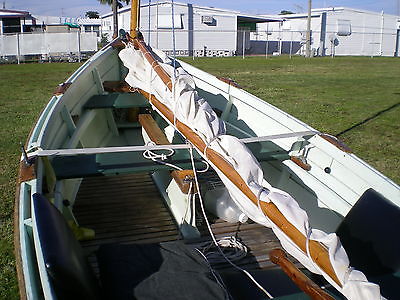
nice wooden dinghy, gaff rig.
St. Petersburg, Florida
Make Home Built
Category Dinghies
Length 10.4
Posted Over 1 Month
Nice wooden dinghy, good condition (need paint?) Look retro. Good mast, boum and gaff . Good sail. No motor. Aluminium oars(new).Ready to sail.
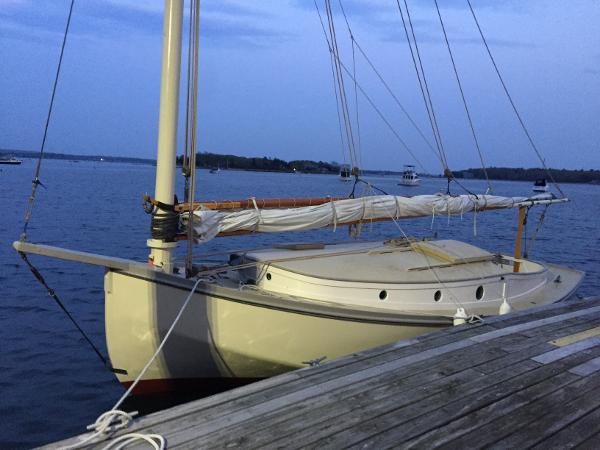
2014 Catboat GAFF RIG, FULLY RESTORED
Newburyport, Massachusetts
Make Catboat
Model GAFF RIG, FULLY RESTORED
2014 Catboat GAFF RIG, FULLY RESTORED Major Price Reduction 6/22. Seller has no time for her. 100 years sailing Babylon YC Regattas and Great South Bay. Built in Connecticut as a seagoing yacht. 100% professionally rebuilt. This is an opportunity to own a very fine, like new but truly classic cruising cat. Replacement value more than $200,000! Her rebuild included many maintenance saving re-construction modernizations. However, care was taken to preserve her authenticity. Sabb diesel with keel cooler (900 hrs), variable pitch prop and optional hand start... parts easily obtained and inexpensive. Extremely reliable and effecient (10nm/gal @ hull speed). Vessel is dialed in and loves a 20 knot breeze. Her distinctive flared bow and "V" hull give her strong, smooth windward characteristics unusual for a catboat. She is a capable offshore vessel, truly sensational sailing as comfortable in heavy offshore conditions as she is nimble around the club. You will be greeted with interest and awe at every port of call. "Sea Rover" is actively sailing between Martha's Vineyard, the Westport river, MA, and Onset Bay. Asking $29,000. LOD: 26' LOA: 27.5' Beam: 10'11" Draft: 34" Aux. Propulsion: Sabb Diesel Motor: manual and elect start, keel cooled, variable pitch prop. (900 hrs) Sail just recon'd by NorthSails, good condition All bronze hardware 7 Bronze portlights Manual Marine Head Bronze Centerboard Winch, Stainless Steel Cable Mahogany/Bronze Boathook Fenders Tiller Tender System Louvered Oak Washboards Varnished Gaff & Boom Wooden/Bronze Blocks Cedar on Oak Hull Mahogany Coaming, Toerail, Pulpit Spare Masthead Halyard 2 Oversized anchors, 3 rodes Pulpit with Anchor Roller and Alternate heavy duty Mooring Chalk Teak cockpit sole w/2 Large Bronze Scuppers New Posh II running rigging from R & W Rope 2 Epoxied Alum water tanks (35 g) 20g Epoxied Aluminum Fuel Tank w Water/Debris Catch Edson Manual and Rule Electric Bilge Pumps Completely and professionally rebuilt utilizing modern technology where possible to lower maintenance but strictly adhering to her authenticity. She is like a new boat! This offshore capable and striking classic has just turned 100 years old! You'd never guess. Cabin can sleep 3 comfortably and has flip up dinettes on the centerboard trunk. The corian sink has a brass water pump beside oak counter. Cozy lighting is by kerosene gimballed lantern or overhead 12v. Dual battery switch and 12 volt breaker panel. Lots of dry storage compartments. Equipped with Balmar high performance charge regulator giving optimally rapid battery re-charge. Sea Rover is strong, gorgeous and well designed. You will be met with enthuiastic interest and awe at all your ports of call with Sea Rover.

1982 Scheeps & Jachtbouw Steel Gaff Rigged Ketch
Deltaville, Virginia
1982 Scheeps & Jachtbouw Steel Gaff Rigged Ketch 'Pacifique' is a Louis Van De Wiele designed boat, based on the famous 'Omoo', which was sailed round the world from 1949 - 1953 by famous Belgian yachtswoman Annie Van de Wiele. This boat was built by one of the Scheeps and Jachtbouw Boatyards in Weidewiek, Netherlands and smacks of traditional boating at its best. With 5mm cold galvanized,epoxy coated overlapping steel plates on the hull and 4mm epoxy coated steel decks, she is extremely strong and built particularly to voyage in temperate latitudes and has been as far north as Greenland. She can handle any weather conditions. The current owner had her built in 1980/1 and has been cruising her, either full time or part time, ever since. However, it is time to move to shore and leave the sailing to someone younger, but with the passion. The strong steel hull is as good as new, the interior is functional, the rigging is largely block and tackle/dead eye, the gaff-rigged ketch sail plan will have traditionalists 'oohing and ahing', the long bowsprit adds to the sail area and to the fabulous lines of this head-turning sailing vessel. The owner is motivated to sell and will entertain reasonable offers from genuine buyers who are looking to live the dream.

16' 1933 Crosby Gaff Rigged Catboat
Dedham, Massachusetts
Please contact the owner directly @ 781-326-3362 or glsass(at)live(dot)com. JENNY- 16' Catboat, cuddy cabin, spruce mast w/douglas fir boom and gaff. In excellent condition with Garmin GPS, 2 mooring pennants, 5hp 1999 Mercury OB, new batteries, Danforth anchor,pickup stick, cockpit bench cushions and rudder lock. 2001 Ventura Model VB-2200 trailer. New cockpit, sail cover and mast boot. Flexible solar panel battery charger. Electric bilge pump. Custom keel blocks and jack stands. Interior contains 2 storage shelves (port/starboard) and new pine ceiling. Marblehead/Manchester Sailoar 8 sailing dinghy, leathered oars, bronze oar locks, new centerboard, rudder, sprit rig with new sail (2012). This is a face to face sale ( name, address, telephone, etc.) no cryptic messages or couriers, no PayPal payments, bank or certified checks only. These boats are offered as a single unit and NOT available separately. Serious offers only, NO TRADES CONSIDERED.
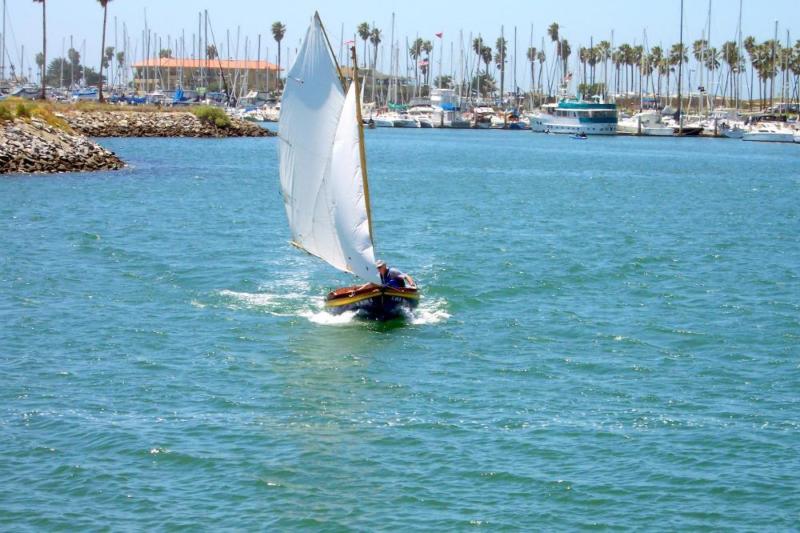
16' Gaff Rigged Sloop Somes Sound 12 1/2
Fillmore, California
Designed to sail Buzzards Bay and other rough water like San Francisco Bay, her stability has not been exceeded by any other vessel this size. The Somes Sound 12 1/2 is the third generation of Nathaniel Herreshoff's H12 1/2. A glued lapstrake hull built with 3/8" marine plywood and 600 lbs of lead ballast give her excellent stability and speed on the water. A self tacking jib, 134 sq ft of sail, a six foot beam, and a weighted centerboard make her a dream to sail. Accessories include , built in radio, two electric bilge pumps, 12v battery, electric trolling motor, EZ Loader trailer with swing tongue. Asking price is $14,900 or best offer.
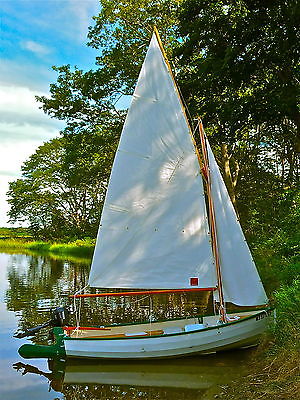
Stornoway 12 Gaff Rigged Sailboat, Engine, Oars, and Trailer
Somerville, Massachusetts
Make Stornoway
British designed Stornoway 12, gaff main with jib, centerboard. Beautiful composite built from best marine ply and epoxy by meticulous amateur craftsman. Fine vessel for rowing, sailing, or motoring. Needs nothing as this is a complete package. Have all paperwork for the boat and trailer. Good trailer and like-new 2.5 HP 4-stroke Yamaha outboard. Sails in excellent condition. This is a comfortable, safe, and dry boat in ready-to-go condition. The British take their sailing dinghys seriously! Further information at SelwayFisher.com Stornoway 12 Particulars LOA12'1"3.67m Beam5'1.53m Hull Mid Depth1' 6 1/2"0.47m Draft6"/3'3"0.16/1m Sail Area78 sq.ft7.3 sq.m Approx. Dry Weight135 lbs62 kg Hull Shape Multi-chine with 6 planks per side Construction MethodStitch and tape - mould/jig given for clinker ply Major plywood requirements for hull5 x sheets of 6mm exterior or marine plywood Guidance Use3 adults rowing/motoring - 2 adults sailing
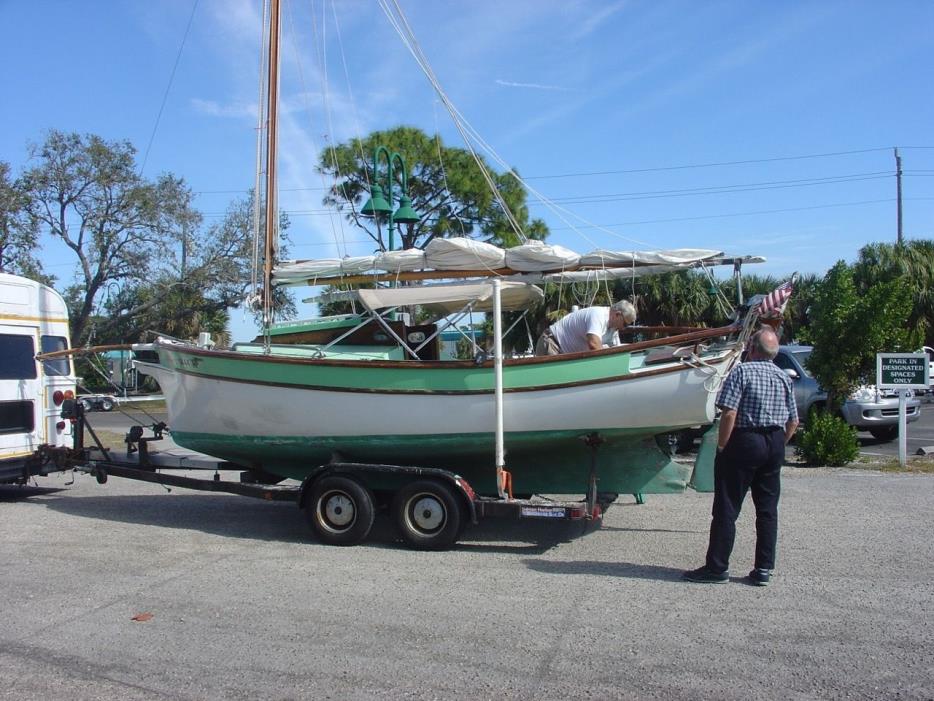
Sailboat, 21ft, Gaff topsail cutter rig, motor, trailer, 8 sails, rigging
Adams Run, South Carolina
Make Windjammer Yachts
Model Gaff Topsail, Cutter
Category Cruiser Motorcycles
Length 21.0
This is Hull #1, 1961, Windjammer 21's from California, designed by Morgan Embrogan and built in Southern California back in the 60's and early 70's by various commercial builders. There were at least 15 built and I have a gaff-rigged, topsail cutter. This Windjammer sailed to Hawaii and back from California twice and to Alaska and back to CA. boats have very easily folded masts, even under sail, fit into US containers (24). The Windjammer 21 will sleep 4 in separate bunks and is very comfortable under way and in the slip. With quadrant centerboard up it draw 18 inches and weight empty is 2500#. It has always been great in the Channel Islands because it cuts over the kelp and because it is so light we used to tie off to the kelp (don't shoot me) to keep from carrying 600' feet of line and extra chain necessary to normal anchor around the islands. Boat is in Charleston, SC now on a trailer. Steel trailer has 4 new tires, wheels, bearings, recently pulled from Florida. 6 bags of sails, all rigging, outboard in a well, boat is ready to sail but could use some TLC, paint, varnish, etc. Photo of Black hull boat is a sistership. Could deliver for a fee if needed after purchase.
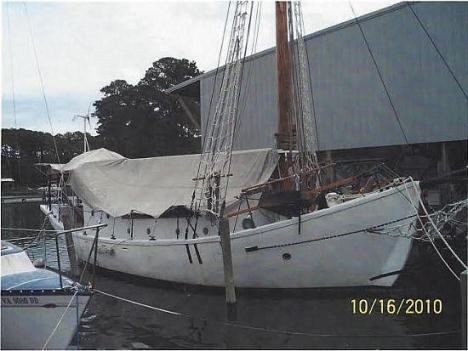
38' 1903 Saroukos Sponge Sail
Mathews, Virginia
Please contact owner Martin at 804-512-eight five three zero. Boat is located in Mathews, Virginia. Coll molded over cypress, gaff rigg . Sails, rebuilt diesel,new hot water heater,new compost toilet , solar panels and wind generator. Tons of stuff anchors blocks. Good live aboard. This boat was built in tarpon springs. If it doesnt sell I'll take it there for sunset cruising. Could even lease for that purpose .

17 ft. Gaff Haven 12 1/2 Sailboat. Centerboard version of the Herreshoff 12 1/2
Grosse Pointe, Michigan
Make Custom Built
Length 17.0
The Haven 12 1/2 is Joel White's centerboard version of the Herresshoff 12 1/2. This boat was built to the highest standards, completed in 2006. It has a white oak keel and steam bent oak frames. It was built with plank on frame construction over molds at each frame with Atlantic White Cedar. The front deck is 3/8" marine plywood with teak marine grade plywood laminated on top and scribed with lines to represent deck planking. The rest of the wood is all mahogany and teak. The gaff rigged sails (main and jib), are from Center Harbor (Maine) sail makers. The metal hardware is all silicone bronze as are all the screws. All the spars are Sitka Spruce, which is very light weight and very strong. She has Sunbrella main and jib sail covers. There is a marine grade deep discharge 12 volt battery which powers Minn-Kota electric trolling motors for auxiliary power. There is also an AM/FM/Marine stereo system with iphone/ipod input and two mounted speakers. A galvanized wire lifting harness is also included. It comes with a custom built galvanized Triad trailer (~2006), which has a custom mast holder and "sail off" capability. New paint and varnish was completed inside and out in April, 2015 using Epifanes Varnish and George Kirby Jr. paint. The boat is located near Detroit, Michigan - worth the trip! $20,000. Reasonable offers considered. Shipping and payment: Cannot deliver boat. Payment required in full at time of purchase.
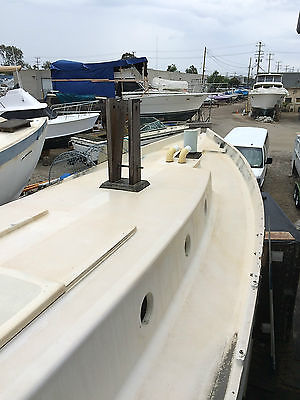
32' DREADNAUGHT UNFINISHED SAIL BOAT PROJECT 2015 TITLED
Huntington Beach, California
Make DREADNAUGHT
Model 32 CUTTER
Length 32.0
32' DREADNAUGHT CUTTER OR GAFF SAIL BOAT PROJECT. 70% FINISHED. OWNER DIED. INCLUDES ALL NEW PARTS. NEW CARBON FIBER MAST WITH CUTTER OR GAFF HARDWARE CUSTOM MADE ALL STAINLESS. BOOM WITH CUSTOM HARDWARE. NEW BOW PULPIT WITH ALL HARDWARE. CUSTOM ANCHOR ROLLER SYSTEM FOR BOW PULPIT. NEW STERN PULPIT WITH HARDWARE AND CUSTOM ANCHOR ROLLER SYSTEM. RUDDER INSTALLED WITH TILLER HANDLE. CUSTOM DEEPER COCK PIT SEATING SETUP FOR SINGLE MAN OPERATION. ALL NEW FUEL TANKS INSTALLED. CUSTOM WATER TANK SYSTEM UNDER FLOOR TOTAL 6 TANKS WITH MANIFOLD SYSTEM. OLDING TANK SYSTEM INSTALLED. GALLEY WITH NEW TWO BURNER STOVE WITH OVEN INCLUDED. REFRIGERATOR BOX INSTALLED NO COOLING SYSTEM. NEW PROP AND SHAFT WITH ALL CUTLESS BEARINGS AND PACKING GLAND. CHAIN PLATES INSTALLED. PORT HOLE WINDOWS INSTALLED. MOST INTERIOR STRUCTURE BUILT. THE OWNER BOUGHT THE BOAT KIT NEW IN 1975 FOR $10,000 AND BUILT ALL THE HARDWARE AND PARTS HIMSELF. HE WAS A AEROSPACE ENGINEER AND DID SOME INCREDIBLE WORK. THE HULL ABOVE THE WATER LINE IS BALSA CORE WITH SOLID PLYWOOD ON ALL CHAIN PLATES. 7,000 LBS LEAD KEEL WAS INSTALLED BY OWNER. I HAVE ALL THE DRAWINGS, ORIGINAL PURCHASE ORDER WITH ALL BUILD INFO, BLUE PRINTS OF CUSTOM ORDERED HULL MATERIAL. DRAWING FROM OWNER OF RIGGING SETUP. THE BOAT IS GOING TO NEED MOTOR AND TRANS. (SET UP FOR TWO CYLINDER YANMAR) RIGGING CABLES. WINCHES AND SAILS. PAINTING OF BOAT. INTERIOR FINISHED. ELECTRICAL. (MOST 120 VOLT INSTALLED) I AM SELLING OFF THESE PARTS ON OTHER AUCTION, THE SOONER THE WHOLE BOAT SELLS THE MORE THE BUYER WILL GET AT THIS PRICE. CALL ME FOR INFO AND LIST OF OTHER PARTS. 562-201-6554 LANDON
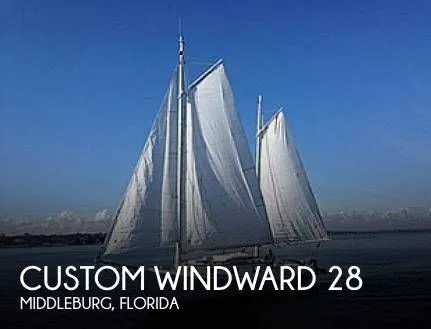
2008 Custom Windward 28
Middleburg, Florida
Make Custom
Model Windward 28
Category Ketch
Everything about this boat appears to be in " better than expected" condition. She has been well cared for and the boat and all of its accessories/components have been stored in a clean, climate-controlled environment. Stock #311714 Karl Stambaugh Design!! Easy to Haul!! Easy to Sail!! Everything Needed to Go Sailing is Included!! BONUS OFFERING!!! The owner of this boat had dozens of books on sailing and sailboat maintenance. Those will be included in the sale of this vessel. This Karl Stambaugh-designed WINDWARD 28 is a cruising version of her successful shallow draft sisters. She is a gaff-rigged ketch and she has generous accommodations in her cabin. Her arrangement is a V-berth forward, galley to port, storage to starboard, two settees, and a porta-potty to pull out from under the bridge deck. Her self-bailing cockpit is large enough for family and friends to spread out. Storage is provided in the lazaret and under the cockpit seats. When not under sail she is powered by a 2006 Tohatsu 6 HP four-stroke engine. She will sail upright and go to windward well as her name indicates. The split ketch gaff rig is easy to handle and reduces easily when white caps appear. Her hull construction is glue and screw 1/2" plywood and epoxy on plywood bulkheads and straight frames. Her sails are in good condition and she comes with all running rigging and the original build plans. She rides on a 2008 aluminum dual axle trailer made by Advanced Boat Trailers of Jacksonville, FL and custom-made for this boat. Since new, when not in the water, this boat has been stored in a climate-controlled inside storage building built specifically for this boat. Bottom line...the owner of this boat had her custom built and he loved her and cared for her like an only child. Check her out!! You will be amazed and impressed!! Reason for selling is owner passed.
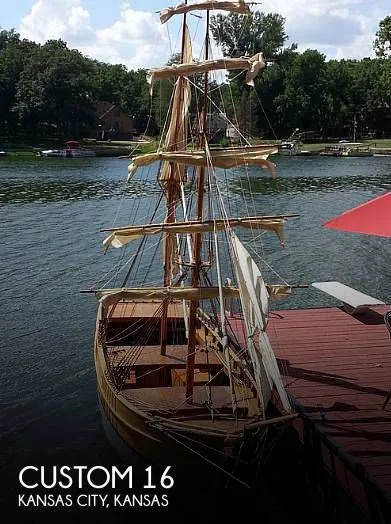
2007 Custom 16
Kansas City, Kansas
Category Other
Very light use and a complete rare design for fun on the water. This is normally stored inside when not in use or enjoyed on fresh water. Completely gone through in 2018 by a former Chris-Craft builder. Stock #176116 The Little Leon is a scale replica of the Square Sail Brigantine "Leon". She was entirely hand built from scratch. A complete one of a kind! Exact 1/8th scale of the famed square rigged Norwegian Brigantine "Leon". Only continue looking if interested in a conversation starter that will turn heads every where it's sailed and docked. A unique hand-made design which is also able to be disassembled and trailered on the included trailer. Seating for 6-8 people enjoy a fantastic sail and steady ride thanks to the onboard water ballast system. The hull sides are Australian hardwood with masts made of American Pine. MAST: Two masts made of pine wood. MAST STEP: The fore mast is stepped on the forward ballast bulkhead. The aft mast is stepped in the bilge SPREADERS: Four spreaders on the fore mast. SHROUDS AND STAYS: The forward mast has eight shrouds both port and starboard, all made of nylon rope. Five are 1/4", one is 3/16", one is 5/32", and one is 3/32". The aft mast has six shrouds on each side, all nylon rope. There are four 1/4", one 5/32", and one 3/32". The foremast also has a total of six upper shrouds. The fore stays are attached to the bowsprit. The back stay of the forward mast is attached to the aft mast. BOOMS: There is a bowsprit and a bow boom. TURNBUCKLES: There are no turnbuckles rather dead-eyes. CHAIN PLATES: The chain plates are Futtlocks. They are 1/8" bronze rods attached to the topsides then attached to the dead-eyes. MAST SUPPORTERS: Hardwood mast partner and mast step, reported as serviceable. SAILS MAINSAIL: There are four square sails on the forward mast. Three stay sails (jibs). There are gaff rigged sails on the aft mast.
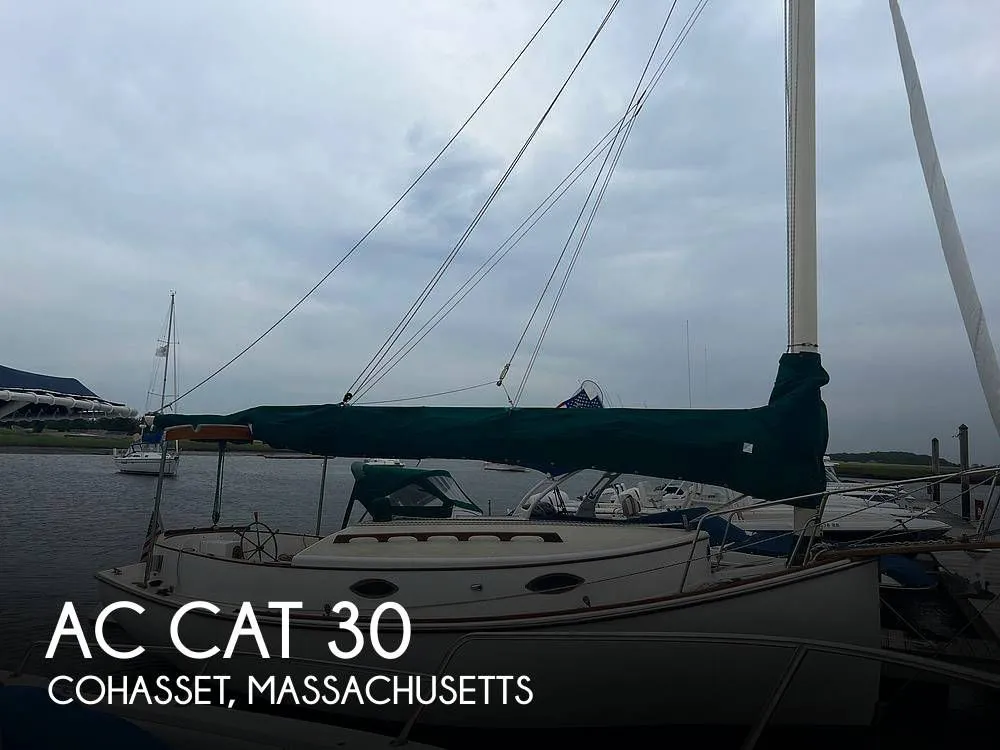
1980 AC Cat 30
Cohasset, Massachusetts
Make AC Cat
Category Cruiser
Everything on this boat works as it should, the owner confirms. It will make a beautiful day sailer, weekender, or longer-range sailer for her next owners. Get ready to sail away today! Stock #299074 Custom Re-Fit! Over 6' Headroom Below! Power Winch! Half-Dodger! Battenless Mainsail! This custom sailer was professionally converted from an Atlantic City Cat in 2009. With a spacious 24' on deck and an 11-foot beam, she has plenty of room above for coastal cruising or entertaining. The cockpit can accommodate up to 8 people. Below she has over 6 feet of headroom in the cabin making for comfortable quarters. There is a very comfortable settee with a table that converts to a double bunk. There is also a single berth starboard and a quarter berth double. This vessel has been rehabbed. The original engine was replaced by a Volvo Penta MD 20-30 diesel and a large prop was installed to allow her to get up to 8 knots. There is a roomy head and galley with hot and cold pressured water. She has been upgraded with updated electronics including a Garmin plotter and Raymarine autopilot. She can be steered under a dodger in wet or windy weather. A carbon fiber boom and gaff, plus a power winch and boom gallows make for easy rig handling. The added plank bowsprit with stainless steel pulpit and Spartan anchor roller makes for safety and comfort. She is also equipped with a roller furling jib. She has everything needed for enjoyable sailing, entertaining, and cruising. She cruises comfortably under power, doing 6 knots at 2,700 RPM, and can do 8 knots in the 3,300 to 3,500 RPM range for a good bit. Comfortable underway and at anchor, this 1980 O Donnell is the perfect boat for a day or weekend away.

1964 Herman Cat Catboat 17’
Cape May Court House, New Jersey
Make Herman Cat
Model Catboat 17’
Category Daysailer Sailboats
1964 Herman Catboat 17’ One of a kind, maybe the prototype? Fully updated in 2009. New Yanmar engine in 2009. Sail new in 2013. Gaff rigged, Tabernacle mast. Includes trailer. Asking $9950
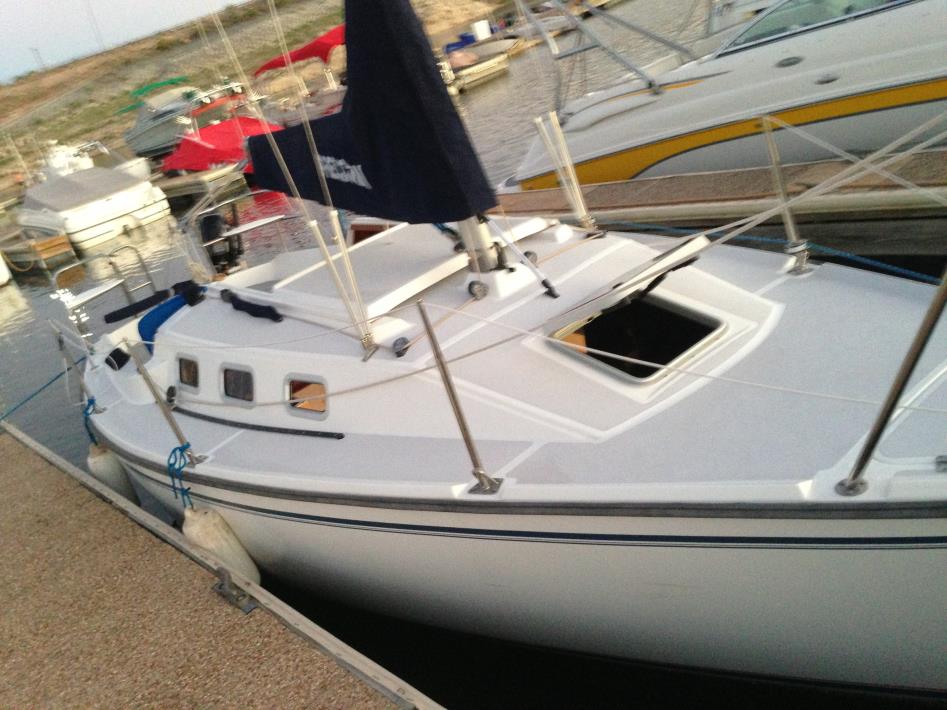
2004 Precision P-23
Peoria, Arizona
Make Precision
Category Sloop Sailboats
2004 Precision P-23 this boat is in very good condition, original owners. 8'6" beam, draft 1'11", 5'4" board down, displacement-2,450 lbs. ballast 850 lbs fixed lead, sail 248 sq. ft. mast above dwl-35'4". porta-pot, alchohol stove, galley, inverter, stereo, cockpit cushions, motor, winch, rail, tiller & sail covers, grill, anchor & rode, 2 brand new batteries, 7'3" cockpit, 48 qt.ice chest, new motor mount, very new nissan 6hp 4 stroke motor, whisker pole, gaff, brand new alluminum foil & furler, depth finder and knot meter, small adjustable back stay. all running rigging is fine, factory 2 axle trailer w spare tire, trailer has extendable clutch for easy de-masting and is in very good condition.
Narrow Results
Current search reset all.
- Keyword: gaff sail
- Com-Pac (4)
- Custom Built (2)
- Herreshoff (2)
- Catboat (1)
- DREADNAUGHT (1)
- Flicka Pacific Seacraft (1)
- Herman Cat (1)
- Home Built (1)
- Jarvis Newman (1)
- Precision (1)
- Stornoway (1)
- Windjammer Yachts (1)
- Daysailer Sailboats (7)
- Cruiser Motorcycles (2)
- Dinghies (2)
- Cruiser (1)
- Sailboats (1)
- Sloop Sailboats (1)
- Florida (9)
- Massachusetts (6)
- California (3)
- Michigan (3)
- New Jersey (3)
- New York (3)
- Arizona (2)
- Rhode Island (2)
- Virginia (2)
- Illinois (1)
- Indiana (1)
- Maryland (1)
- North Carolina (1)
- South Carolina (1)
- POP Yachts (3)
- Search Title Only
- Has Picture
- Include Sold Listings
Showcase Ads

2014 Craig Cat Elite II
Mulberry, FL

2009 JC Manufacturing Neptoon 25 TT Sport
Osage Beach, MO

2006 Boston Whaler 150 Montauk
Chenequa, WI

2017 Sportsman 212 Heritage
Sarasota, FL

2016 Nitro Z20

2001 Baja 250 Islander CC
Kenneth City, FL

2017 Yamaha SX 210
Create Alert
Please, name this search
Select Interval
Alert Successfully Created

IMAGES
VIDEO
COMMENTS
Gaff rigs typically provide more sail area for the same mast length, which results in less stress on the mast and rigging. This allows for a shorter (and therefore stronger) mast and softer and simpler rigging. This results in less hardware, fewer points of failure, and therefore, less maintenance cost.
Gaff rig. Gaff rig [1] is a sailing rig (configuration of sails, mast and stays) in which the sail is four-cornered, fore-and-aft rigged, controlled at its peak and, usually, its entire head by a spar (pole) called the gaff. Because of the size and shape of the sail, a gaff rig will have running backstays rather than permanent backstays.
Introduction: Sailing enthusiasts around the world have always been captivated by the elegance and timeless beauty of traditional sailing vessels.One such vessel that embodies this allure is the gaff rig, a distinctive sail plan known for its versatility and intricate design.In this comprehensive guide, we will delve into the details of the gaff rig diagram, unraveling its intricacies with ...
To attach the boom and headsail on a gaff rig sailboat, follow these steps: 1. Position the boom: Place the boom on the mast and slide it toward the aft end until it aligns with the jaws of the gaff spar. 2. Secure the boom: Attach the boom to the jaws of the gaff spar using a stainless-steel pin or bolt.
A gaff rig employs a spar on the top of the sail and typically other sails can be set in conjunction with that mainsail with the gaff. Often, on the smaller, non tall ship, gaff rigs, there will be a small triangular sail that fits between the main and the mast like a puzzle piece - this is the topsail. The gaff rig was the standard manner of ...
Gaff rigged sailing vessels, with their distinctive '4-cornered-but-triangular-shaped' sails and rich history, have been an integral part of maritime culture for centuries. This style of rigging has evolved from older sail designs, each adaptation refining its performance and versatility. The gaff rig stands as a testament to the ingenuity ...
Sloop rigged sailboats (Bermuda Rig) is the most common sail rig and popular with racing sailboats as well. ... A gaff rig sailboat hoists a 4-cornered sail, instead of the triangular, 3-cornered Bermuda rig. This rig isn't very common in smaller sailboats anymore, although many older ketch style sailboats did originally have gaff sails. ...
The gaff could double up as a derrick for lifting cargo and equipment on or off the boat. In summary, the gaff was simple and robust, practical and seamanlike, and crucially, cost effective. Smack 'Bertha' 1968 ©OGA Archives. In contrast the Bermudan rig evolved at the behest of the leisure sailor and was only feasible due to new innovations ...
Gaff and gunter rigged sailboats look similar, but which rig works best on a cruising dinghy? In this video, I show you how I rig my cruising dinghy moonligh...
I've received lots of questions about handling a gaff rig, enough to make a separate video on the subject. This video turned out to be much harder to make ...
https://improvesailing.com/sails - If you want to learn the rig sail types for sailboats, this video is for you. I've done a ton of research to learn how to ...
The sail itself is best proportioned with the following ratios: luff 1.0, head 0.833, leech 1.73 and foot 1.02, according to John Leather's The Gaff Rig Handbook. This "best proportion" is not always followed, of course, but in Leather's ideal gaff main sail, the angle of the gaff to the mast should be at 30 degrees, and the boom should rake ...
Friendship Sloop in c. 1920. Fiberglass Friendship Sloop Bay Lady (launched in 1979) Diagram of a Friendship Sloop. The Friendship sloop, also known as a Muscongus Bay sloop or lobster sloop, is a gaff-rigged working boat design that originated in Friendship, Maine around 1880 and has survived as a traditional-style sailboat .
SOME EXAMPLES OF GAFF RIG SIMPLICITY. Joshua Slocum's circumnavigation of the planet, done over 100 years ago, was made on an elderly gaff rigged oyster sloop given to Slocum as a gift. Photos #5, 6 and 7 all refer to that sloop, called Spray. She was 39 feet, 6 inches overall; 14 feet, 2 inches in beam; with a draft of 4 feet, 2 inches.
Short answer gaff rig sloop: A gaff rig sloop is a type of sailing vessel characterized by its triangular mainsail with a fore-and-aft rig. The mast is usually positioned further back on the boat compared to other sloops, allowing for a larger headsail. This traditional rig offers increased sail area and versatility while retaining simplicity.
A gaff rig sailboat is a type of sailing vessel that features a specific rigging system consisting of a four-sided fore-and-aft sail called a gaff sail. This traditional design offers numerous advantages including simplicity, ease of handling, and excellent downwind performance. Gaff rigged boats are commonly seen in traditional and ...
A catboat is a boat that is traditionally fitted with a gaff-rigged sail on a single mast set well up in the "eyes" of the boat. Cruising catboats have cabins and normally range in overall length from 16 - 26 feet. Others are fully or partially decked and suitable for day sailing or camp cruising. Most cats have centerboards, although some keel ...
Larger furling headsail and inboard rudder. A beautiful gaff-rigged sloop developed around 1880 from the fishing and lobstering needs of the men of Muscongus Bay on the Maine coast. The original builders constructed sloops varying in length of 21′ - 50′. Probably the average length would be about 30′ - 40′.
Sep 6, 2002. #2. Gaff cutters. The sailplan on a cutter is a lot more flexible than on a sloop, because you can set the staysail and jib separately or together, depending on wind conditions. On some gaff rigs, you can also set a topsail above the gaff for even more sail area. With the gaff down, the mast is shorter than a sloop, so you can ...
True. However, a gaff-rigged (or a gunter-, or a lug-, or a lanteen-rigged) boat would have the advantage that the spars would all be shorter than the hull of the boat. That can make trailering quite a bit easier. A shorter mast is also easier to raise and take back down. Yes, one gives up a bit of performance by using one of these rigs with ...
We have a special guest this week - custom wooden boat builder, Paul Rollins, who joins us to talk about the boat he built back in 2009 - a Bud McIntosh-des...
1982 Scheeps & Jachtbouw Steel Gaff Rigged Ketch 'Pacifique' is a Louis Van De Wiele designed boat, based on the famous 'Omoo', which was sailed round the world from 1949 - 1953 by famous Belgian yachtswoman Annie Van de Wiele. ... The owner of this boat had dozens of books on sailing and sailboat maintenance. Those will be included in the sale ...